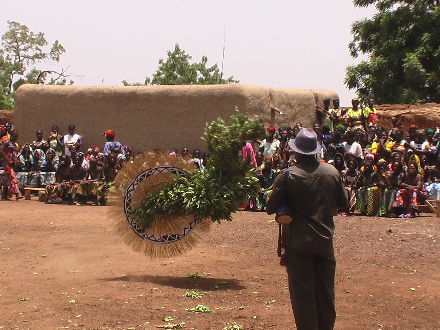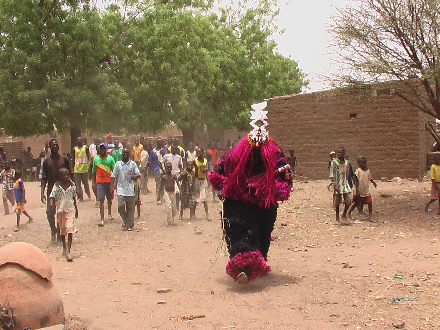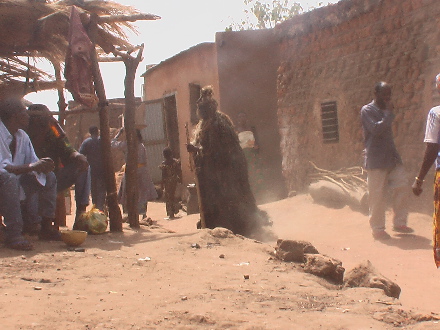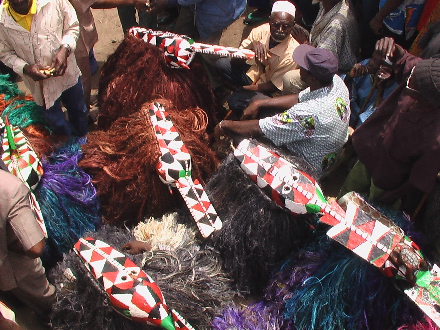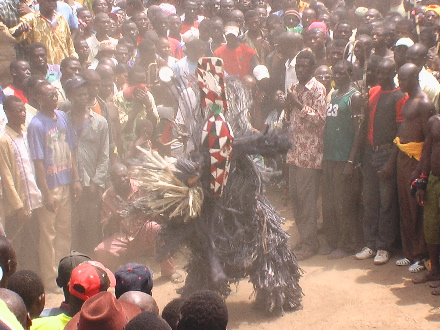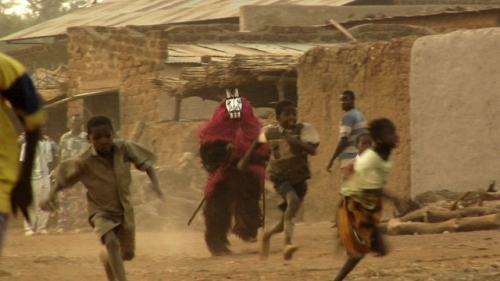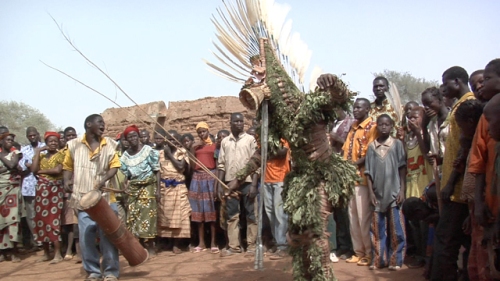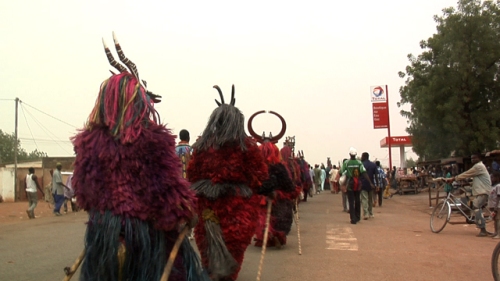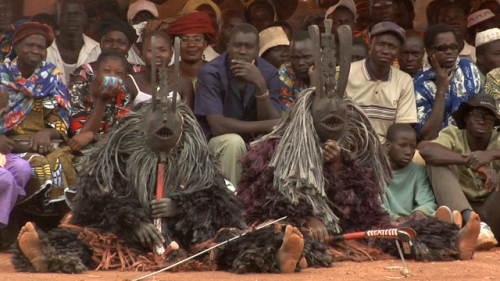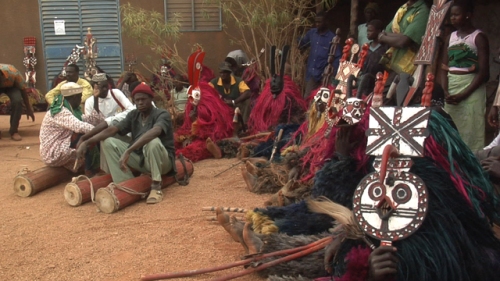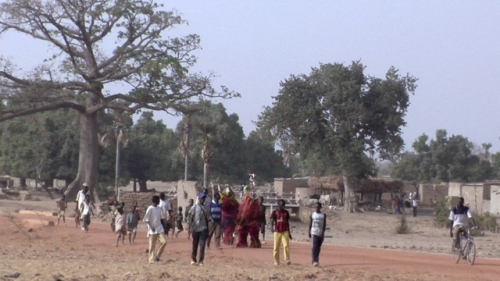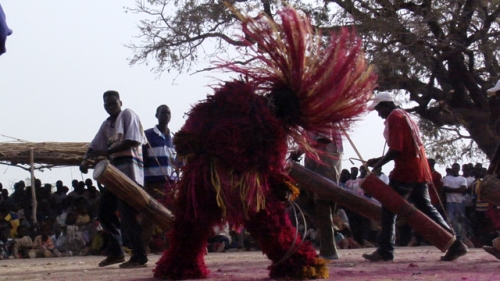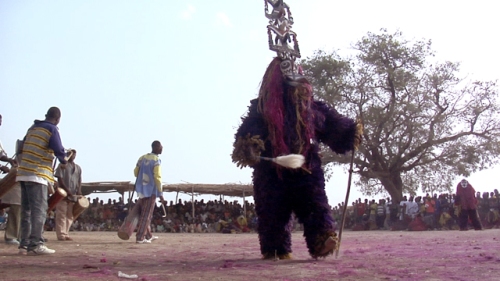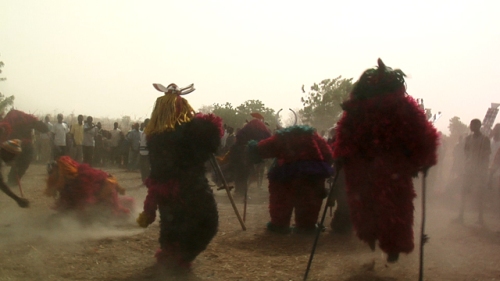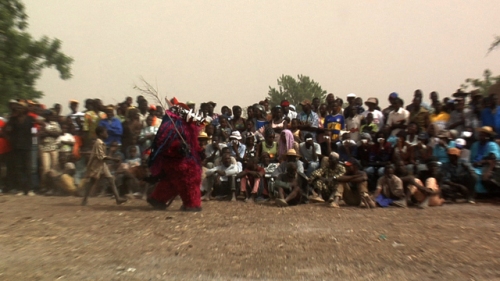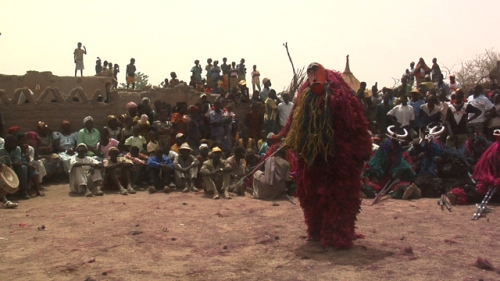IMAGES 2
October 3, 2007
Hey hey… a new blog entry? I thought he was dead. Oh no… I just got back to Ouaga from almost three months of festival-going in the rest of West Africa (stories soon… one hopes), and I thought I’d celebrate my one-year-in-Africa anniversary with some pictures from some other festivals I hit in Burkina (admittedly several months ago). These were all shot with my the dinky video camera that I bring when I don’t want my HD baby to get hurt. It also has a still picture function, which I’ve started using when I sense that I might run out of video. Often it really sucks, but every once in a while, it spits out a gem.
First off, a Bwa leaf mask festival:
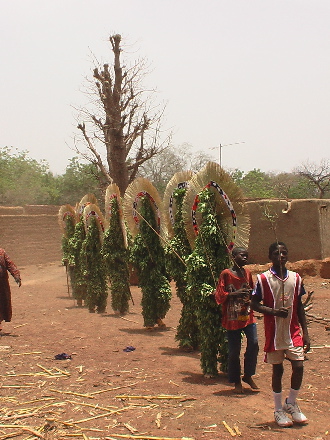
An annual funerary festival at a Nunama village:
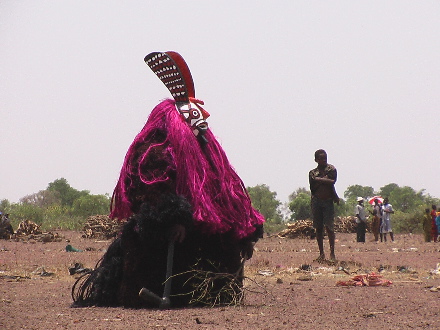
A typically rowdy Bobo village annual funeral:
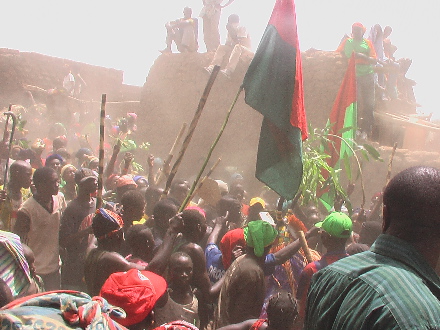
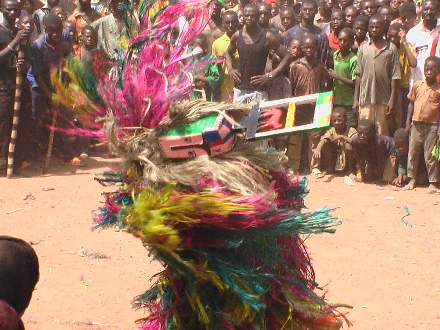
These impressive whirling masks are called wankrs, but I’m far to mature to draw attention to that fact.
Another Bobo funeral, this time in the dramatic hilltop village of Koro:
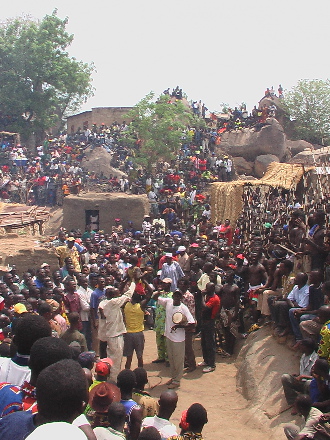
Look closely to see the kid being held aloft in the center there.
That’s right… Circle of freaking LIFE.
A Bwa funeral (apparently the dancers here were all amateurs):
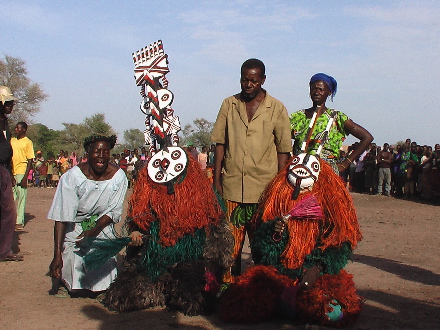
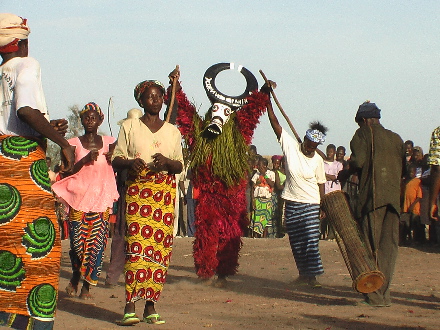
The writing on the buffalo’s horns reads “CDP (the dominant burkinabé political party) lives in Pahin (the town),” showing that even the masks get into the act come election season.
And the last Bobo funeral I attended, which featured some of the weirder masks:
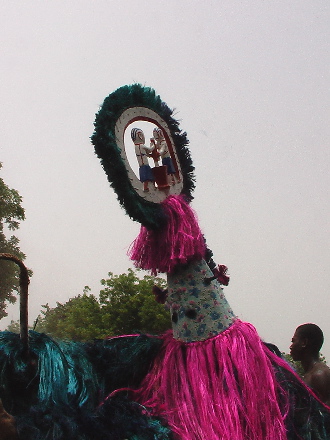
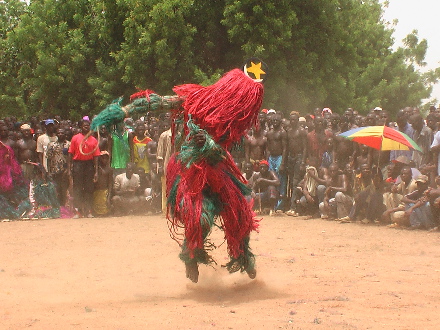
Schnaps! Did I take this picture?
(and note the mask’s red-green colors and gold star… Burkina’s flag)
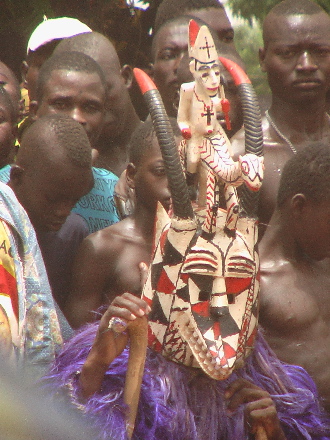
Finally, we have this unexpected and charming interloper mounted on a horse/camel/phallic symbol. For those of you who can’t recognize him, it’s Pope John Paul II.
SOON(ish)! Stories and images from across West Africa. The adventure will thrill and amaze!
IMAGES 1
May 20, 2007
Here are some pics from various masked dance performances I’ve seen throughout Burkina in the past three months. Most are Bwa, Nunama, and Winiama styles and represent spirits of the bush in some form or another… usually recognizable animals. All these images are shrunken stills from HD video I shot at festivals with my nifty new Pansonic HVX-200 (even in these still images, if you listen close, you can hear it screaming in horror and fear at all the dust the masks are kicking up… “No, Dear God… I’m too young to die!” (though in Japanese, of course)). More to come…
FEB 14 – MAR 9
May 20, 2007
Ah, memories… it was more than three months ago, when…
February 14: I picked up Adam Dow at the airport late that night. The airport had somehow metamorphosized into a state-of-the-art facility since I arrived at what I saw as a scraggly low-rent terminal… that or my definition of state-of-the-art has been revised after five months in Africa… probably the latter. I gave him the two-cent tour of Ouaga (is there any other kind?) and then it was straight to work.
February 16-19: Before I helped him cover FESPACO, I drafted Adam to back me up on a funeral festival in good old Sindou. I rented the car again, the beginning of a three-month love-hate relationship that has only just ended, and we set off on the first of what would be countless journeys West. It didn’t take too long for the shit to hit the fan… or something hit the fan… at any rate, two hours into our voyage, it wasn’t working. When we stopped in Boromo to say hi to my friend, Ladji, the car decided not to start. An electrician friend of Ladji’s took a look and replaced a fuse, which fixed the starter, but then noted that the fan wasn’t running. We ended up spending the afternoon by the side of the road as the mechanics jerry-rigged something, and I was introduced to the soon-to-be-familiar but remarkably-cheap process of car repair in Africa… $13 for a two-hour job? Does the union know about this? We made it into Bobo that evening, with just an overheating or two en route.
The next day was the bumpy but thankfully uneventful route through Banfora to Sindou. On arrival we were welcomed as usual by my friend, Tiemogo, and got right down to work. That evening the dancing began and ranged throughout the village. Adam brought two cameras, so we each took one and tried to get a good two-camera shoot out of all the festivities. It was my first chance to film a real masked ritual performance (not the touristy type), and we found out later that it was the first funeral party that had ever been filmed there. Sweet! So it was a great party… or would have been if my food poisoning/giardia/who-the-heck-knows-what didn’t decide to make a return appearance. As it was, I stumbled along, trying to keep up, and occasionally ralphing behind a village hut. Not a little mortifying, as I thought after five months I had had a good immunity built up, but within three days of welcoming my first visitor I fall apart. Adam gave me some grief for not being careful enough about local water and salads, but he had his own health problems a week or two later, and all the bottled water in the world couldn’t help him. But that’s for his blog…
Most of my illness had passed the next day, and we spent the morning filming some more festivities, before heading back to Bobo before the sunset. The following day we paid a visit to a famous group of mask carvers in Boni (on the road between Bobo and Boromo) that I had meant to contact forever. Yacouba Bonde is one of the best carvers in Burkina, and his team sends masks all over the world, as well as organizing tours for the village dancers, who were recently seen at the Quai Branley Museum in Paris. We got a good look at the workshop and a schedule of upcoming events… and we would be back more than once.
That afternoon, about halfway from Boromo back to Ouaga, the front left tire blew. We had said something about adding air back in Sindou, but never got around to it. We pulled out the spare and discovered that it too was deflated… and with it, most of our hopes of returning to Ouaga that night. I left Adam on the side of the road for the bandits (of whom I shouldn’t joke), and hitched a ride with a deputy’s wife, her chauffeur and an SUV filled with firewood and chickens to the next ‘service station’ – a shack with a few tires out front ten minutes down the road. I got the tire replaced and then got the luck to catch a ride in one of the gargantuan rigs that ply the route between the Nigerien and Ivorian borders. Nice guys, those truck drivers, until they’re bearing down on you in the middle of the night, that is. We changed the wheels, and retook the road, with a quick stop back at the tire shack to fill the spare. A smart move that, as fifteen minutes later the tire blew again. In the last of the daylight, we discovered that the spare didn’t fit around the brake shoe, and it was only a bit of last-minute quick-thinking that had us rotating all the tires in order to find the combination that would fit. It worked, and we finally rolled back into Ouaga.
February 20-21: We spent two quick days trying getting some interviews and some info on FESPACO, before heading back out to the villages. While the actual FESPACO organization was anything but (organized, that is), we did have the luck of getting some time in with Gaston Kabore, the godfather of Burkinabé cinema, the founder of IMAGINE Film Institute, and a terrific guy who I managed to contact before Adam arrived. Mr. Kabore proved to be extremely accommodating to a pair of scraggly Americans with vague notions of a web film about African film, even as he and his staff were preparing the Institute for the coming festival. We got a great interview with him, which was marred only by a brief electrical fire we caused in their state-of-the-art editing suite, when our shitty extension cord melted in on itself and short-circuited during our setup for the interview. Thankfully, no one noticed, and we stayed in their good graces for the duration of the fest.
February 22-23: Before we knew it, we were rolling back out to Boni for their village purification ceremony. Both the car and my gut performed much better that time out. We did another two-camera shoot and I got to test out my camera’s HD capabilities in the field, with some pretty good results. We also met Trudy, a wealthy New York mask collector, world traveler, and kook (I don’t think she’d mind me saying that), and her trusty personal guide, Godfried, a really cool guy from Ghana who runs personal tours around West Africa, and, it turns out, is the guide for Carol Beckwith and Angela Fisher, whose massive photography book ‘African Ceremonies’ and related projects are one of the most high-profile in the world of African performance documentation. Cool beans. We stayed for two days to catch the beginning of a funeral performance there, but we couldn’t see much, as we had to get back to Ouaga for FESPACO madness.
February 24-March 3: ‘FESPACO! Cinéma Africain! Tout les deux ans!’ So goes the annoying theme song. FESPACO (Festival Pan-africain du Cinéma et de la Télévision de Ouagadougou) is the oldest and largest film festival in Africa… and the biggest event to hit Burkina Faso. It was begun in the late-60s by a small group of film-lovers when most of the pictures coming out of Africa were documentaries. It very quickly exploded in popularity, adding fictional films and later, video and television categories. A survivor of many threats to its existence, financial and political, this year was its 20th biannual edition. For one week, Ouaga opens all its movie theatres, hosts workshops and panels, and welcomes people from all over the continent and from across the world. Suddenly there are English speakers in town! Jiminy Christmas!
Before Adam arrived, I had contacted the organizers of the opening ceremony, so we sat in on a few rehearsals for that on our prep days and finally did a two camera cover of the event itself at the city’s football stadium… which for all my preparation, ended up being more or less a dud, even if it did feature choreographed horse riders, dozens of modern dancers, hundreds of children, Tahitian drummers, fireworks, a laser show, and performances from the biggest names in Burkinabé and African music. I know… looks good on paper… but, sadly, added up to squat…
We had better luck, and more interesting subject matter the next day at Ouaga’s famous Filmmakers’ Monument, the symbol of the city. We caught a ceremony honoring all the past filmmaking pioneers of Africa, and all the big guys were there, including Danny Glover! Yep, THE Danny Glover. A vehement supporter of African film, the Lethal Weapon is a regular attendee, and this year was screening a film he helped produce about globalization called ‘Bamako’ (it had a run in the States a year or so ago, if I remember right). Mr. Glover treated us to an on-the-spot interview, and an impromptu geography lesson, as he began spouting off the names of African countries represented at this year’s festival. We also touched base with Toni, another Fulbrighter who was just wrapping up her grant in Benin on oral history and slavery. A friend of Sarah Carlson (who visited me during the Dialogue de Corps Dance Festival… you remember), Toni arrived with her son, Ramon. They meant to meet up with her boyfriend, who’s writing a thesis on FESPACO and African film, but the travel agent messed up his flight from the states, so he missed the festival. So much for THAT thesis.
The next week was spent hopping in and out of panels and workshops with our cameras blazing, attempting to catch folks we had a chance of interviewing, and slowly trying to figure out what the heck Adam’s film would end up being. We took some breaks to hang out with Toni and Ramon, as well as catch up Aimé and his filmmaking friends, and at the end of the day, we’d typically fall asleep in a movie theatre trying to actually see some films. Slowly, my camerawork improved, and eventually Adam figured out how to introduce segments without repeating himself too much (‘Welcome back to Ouagadougou and the FESPACO Film Festival, 2007, Festival of African Film, here in Ouagadougou, Burkina Faso, Africa, 2007. FESPACO… African film… Africa… FESPACO… 2007…’). Of course, we didn’t really get a handle on the event until it was almost over.
Friday, the penultimate day of the festival, we headed out to the SIAO site (see earlier editions for the skinny on SIAO) for the awards ceremony for the special prizes. These weren’t the official FESPACO awards, but those given out by other organizations… for example the UN Peace Promotion Prize, or the Hope Prize (funded ironically by the Burkinabé Lottery). While we had interviewed several short filmmakers and students and such, we hadn’t pinned down any feature directors, so once Nigerian filmmaker Newton Aduaka won a prize and I could identify him, I pointed him out to Adam. We had caught his film, ‘Ezra’, a few days before… more to seek out some English-speakers for interviews than for the film itself, but we were both very impressed by it, a searing tale of child soldiers in Sierra Leone, and counted it among the best of the fest. Adam got the promise of an interview after the awards ceremony… during which Newton walked away with three more prizes. In the end, though we were all set up there, he needed to get back to his hotel, but promised us the interview there. We followed in short order and caught up with him at the Hotel Independence restaurant. We had a really great interview, and he turned out to be a really great guy with a lot of smart perspectives. Yet as we wrapped up, he discovered that during the interview, his bag, with his iPod and plane ticket among other things, had been stolen! Cripes! We looked all over, asked everyone who passed through, reviewed the videotape looking for clues in the windows’ reflections like on CSI, all with no luck. Here we were, witnesses to both the highs and lows of a filmmaker’s FESPACO experience. We went home feeling not a little guilty, but we would be back the next day for more interviews and to see if there was anything we could do.
I had known that the Hotel Independence, Burkina’s oldest classy establishment (though no longer the classiest), was home for most visiting filmmakers, but I had pictured a fortress closed to the outside world where the stars glided past surly security guards in search of rest and privacy. Far from it. The next day, we walked straight into the hotel no questions asked and strolled poolside to find small swarms of media circling perfectly accommodating filmmakers… all the big directors were there just hanging out talking film… sometimes with a camera in their face, sometimes not. We got several other good interviews, including one with Senegalese filmmaker Moussa Sene Absa, a great character, whose ‘Madame Brouette’ is one of my favorite African films. We were in the midst of interviewing one of Newton’s friends, Ghanian-English documentarian John Akomfrah, who makes films about such uncredibly cool subjects as Fela Kuti and Afro-Futurism and was laying out hipness on a level we could barely comprehend, when Newton and another Nigerian friend showed up. Mak Kusare was another filmmaker, but if that ever doesn’t work out, he can go into private investigations. Less than 24 hours after Newton’s bag was stolen, he had somehow tracked down not only the thief, but Ouagadougou’s King of Petty Thieves, as well. No seriously… the city’s KING OF THIEVES. We have a king of thieves!!! And Mak got his PHONE NUMBER. He was currently in the process of negotiating for the bag’s return, and it was looking good, except that the price went up when they figured out whose bag it was. At any rate, it looked like things were going to work out. But, jeez… only a Nigerian could walk into a strange city and figure out all the inner workings of its criminal underworld in a matter of hours. Impressive!
That night was the big closing ceremony and the presentation of the festival awards back at the stadium. We were in the press pit as the winners were announced. Unfortunately, as the night moved on, practically no one we knew won anything… it seemed we had focused on all the wrong films. But imagine our joy when, out of nowhere, the Golden Stallion, FESPACO’s grand prize, went to ‘Ezra’ and Newton Aduaka. Hot Shit! Blaise Compaore, our esteemed president, presented the award, but unfortunately the idiots in charge of the festival started the fireworks off immediately, drowning out Newton’s acceptance speech. Like I said, the FESPACO organization was anything but (…organized, that is).
All in all, I got a lot more out of FESPACO that I thought I would. From the perspective of an organized festival (one of the things I’m investigating out here) it left a lot to be desired, in spite of its sprawling size and all the money thrown at it… regular festival-goers say it’s grown too big for its britches. And, let’s face the facts, the films I saw weren’t all that great. But I learned a lot about African film in the course of preparing for the documentary, and through all the folks we talked to while filming. And we found a really inspiring group of open and passionate artists who are in the progress of crafting a new cinematic voice in the world. It’s too bad we took all festival to figure out how to enjoy it, but there’s always next edition. 2009! FESPACO! African film! A festival! In Ouagadougou! Burkina Faso! Africa! Film! FESPACO! 2009! Festival of African film… FESPACO… Africa… Film… Burkina…
March 4-9: No rest for the weary. The day after FESPACO we drove back out to Boni for another performance… this time of their famous leaf masks (masks made out of leaves). I guess we missed most of the show, but they kept two of the masks around to dance for us when we got there, which was nice of them. Then we swung back to Ouaga to shoot some last minute pickup shots and interviews for the doc, before Adam caught his flight back to Paris that Wednesday. Or so I thought. He called up the next day to say that Air France had sold his seat by the time I dropped him off and had given him a free ticket anywhere in the world, and two nights stay in Ouaga’s ritziest hotel. The lucky bastard had hot water for Christ’s sake. I guess he spent the time working on the film… I myself was back on the road, this time with two busloads of University students on our way to a professor’s village, Zawara, and the mask ceremony therein.
And so began two months of roaming the countryside looking for masked dances. ‘Tis the season, February through May. Before the rains start again and everyone gets busy in the fields, they have just enough time to placate the bush spirits and send the recently deceased to a decent afterlife with a wicked party. That’s what’s been keeping me busy for the past few months… I’ll post some highlights in a bit.
But first, it’s my mother’s birthday, and that means, PICTURES… So look out for them in the next edition! (Actually, I’m uploading them now).
P.S. Adam has left the pages of my blog, but not the shores of adventure. From Paris he flew to Mumbai/Bombay to spend five months hanging out in Bollywood with his cinematographer friend, Viraj. He’ll be trying to make a series of short internet films about Indian filmmaking, but for the moment, I understand he’s braving sex temples and albino rhinoceroses in the Northeast province of Assam on a gig shooting a promotional video for their tourism board. Those of you who followed my Asian adventures might suspect that I am a bit jealous of Adam’s return to Mother India, the Land of Contradictions… and every so often, I do sit in the blazing African sun, fighting off Bantu-spewing street vendors and choking on dust and car fumes, and wishing I was sitting in the blazing Indian sun, fighting off Hindi-spewing street vendors and choking on dust and car fumes… Ah well.
At least the beer is cheaper here.
JAN 10 – FEB 13
March 22, 2007
Okay, where was I?… Oh, just two and a half months ago…
January 10: Getting out of Dogon country was only part of getting to Timbuktu. I didn’t know where to find a 4×4 in Mopti, and ended up waiting at the Sevare crossroads for another hour, watching as several caravans of whiteys made their way out of town to get to the festival in time. I was very close to hitchhiking, but as much as the image of me on the side of the road with a sign saying ‘Timbuktu or bust’ in one hand and a thumb out of the other might amuse all of you, I was finally directed to the proper departure point in just enough time to catch one of the last trips up north. I squeezed in the back seat with a Peace Corps worker and her brother and sister-in-law from Oakland. Their West Coastiness was evident as they were the only people on the whole trip who were impressed that I brought a Timbuk2 bag to Timbuktu (yeah… I know. The ONLY people… I can’t believe it either).
The ten-hour-plus ride (the plus is for when you are pulled over three times at the same goddamn Sevare crossroads because the cops keep finding excuses to shake down your driver for bribes) skirts the northern edge of the Bandiagara escarpment, before heading off-road. Then it’s several hours across the desert, featuring occasional grazing camels and nomadic village settlements, but mostly consisting of scrub and dirt. My first view of the Niger proper was when we arrived at its banks for the river crossing an hour or two before sunset. There were a few fishers’ huts and some canoes plying the water… very picturesque… and then there were the dozens of vehicles bearing Westerners (and a few Africans) of all shapes and sizes waiting for the ferry. It was kind of a cool experience to travel around in Mali for a week or so and run into a bunch of folks who were all ultimately heading up to the festival, and then to start seeing them again… it had the feel of a pilgrimage. After quite a wait (though not as bad as I thought it would be on the ferry’s busiest day of the year), we were crossing the Niger as the stars came out. Timbuktu was a quick half hour from the ferry, and we drove straight into the winding alleys of the old town to emerge in the central market. I said see-you-soon to my fellow Americans, and followed a kid who looked like he knew where he was going to my friend’s place. After several false stops (he didn’t know where he was going), I finally arrived.
Some Timbuktu background might be necessary, since to most of us, it’s just a name that equals really-fucking-far-away. Timbuktu was important crossroads of the salt routes across the Sahara and the Niger for centuries, and became a haven for Muslims and traders throughout the region. Fortunes fell with a Moroccan invasion in the end of16th Century, and various sackings from Mossi, Fulani, and Tuareg armies, and the city was rendered a sandy shell of its former self. However, noone told Europe, and the rumors of Timbuktu’s mystic splendor endured until the great push of African exploration of the 1800s. With miles of desert and hostile natives to contend with, only a few explorers returned alive, and their disappointing reports were hardly believed until the French arrived and the colonial period began in earnest. Timbuktu remains one of the great disappointments to the casual African traveler, still very hard to get to, and still with very little to offer.
One area that is getting some attention again after years of neglect is the tradition of Islamic scholarship. Invaders weren’t very interested in books (with some exceptions), and the ancient family-owned libraries have survived for centuries. They remained in use up until the French instituted institutionalized education, when they became the forgotten relics that grandpa kept in the attic. Serious work is now being down to find, collect, and preserve these manuscripts, and to see what other elements of the literary tradition remain, including calligraphy, illumination, and the like. One of the other Fulbrighters this year is a photographer who is working on documenting the traditions. She’s staying at one of the libraries, run by a descendant of an Islamic scholar who escaped from Toledo, Spain during the Spanish Inquisition (just like me!… sort of… in that I’m an agnostic scholar who escaped from Toledo, Ohio during the first Bush administration).
I met Alexandra at the Fulbright orientation in DC last summer, picked her brain about taking expensive digital photographic equipment into dusty hot climates, and agreed to keep in touch regarding the Festival au Desert on her end, and FESPACO on mine. She already had two other friends and her brother out for the festival, but was still cool enough to find space to put me up (or rather, get the folks at the library to put me up). Once I got in and got cleaned up, we ran out to a performance that was being held to promote Timbuktu’s candidacy as one of the new 7 Wonders of the Ancient World (I guess someone started an online voting process to nominate new wonders after they found out that 6 out of 7 have been gone for over two millennia). The show featured essays from students, presentation of recent initiates (a gaggle of preteens looking a little pale and wobbly… which I guess is understandable after what they just lost), a quick and dirty demonstration of a traditional wedding, and some good singers with two (yes, TWO!) midget backup dancers. (Midget aside: it’s actually quite common to see dwarves and little people on stage with singers around these parts… though I don’t know if Kid Rock got the idea from here or vice versa.) Anyway, it was interesting, but I don’t know if it did much to convince the attending judges of the ancient wonder of Timbuktu.
On the way back from the show that night, Alexandra asked her brother if he wanted to hear something he didn’t want to hear. He said sure (of course). Alexandra then proceeded to describe a little ritual that is a popular tradition among the local boys. WARNING!!! DO NOT READ ON IF YOU HAVE ANY AFFECTION FOR OUR FELINE FRIENDS OR IF WANT TO RETAIN SOME SHRED OF BELIEF IN MANKIND’S INHERENT GOODNESS!!! Still with me? Don’t say I didn’t warn you. Apparently, the local boys gather together in gangs and hunt the cats in town. Once they kill one, which I can’t imagine is in the humane animal-shelter fashion, they smoke the meat and hide it in whatever abandoned-building-at-the-edge-of-town they use for a hangout. Then they tie the cat’s hide around their waist and go from door-to-door singing the ‘cat-killing song’. In this way they solicit food from the adults, which they take back to their hideout and use to prepare a huge feast that they eat with the cat meat. Hooray! The practice is especially strange in a Muslim city, when cats are supposed to be protected by the faith. But apparently an older mentality dictates that the mystic power of cats is passed on to the boys. Cats are kept by a lot of households in Timbuktu, but apparently there’s an unwritten rule that says that once the cat is outside the family compound, it’s fair game (an unwritten rule that goes for chickens too, apparently). As if to prove her point, and with perfect timing to drive home the grotesque scenario, Alexandra pointed up at some telephone lines lit by a shaft from a streetlight. Sure enough, there, like so many tossed tennis shoes and looking as innocuous as stray paper bags before closer inspection, hung half a dozen draped and dried cat pelts. ‘You don’t notice them until someone points them out,’ she said ominously, ‘But then you can’t help noticing them all the time.’ Yikes!
OK… CAT LOVERS AND WIMPS CAN REJOIN THE ACTION NOW…
January 11: The Festival au Desert started as a traditional gathering of the nomadic Tuareg people to trade, reinforce familial links, arrange marriages, and the like. About five years ago, partly in response to the end of the Civil War between the Tuaregs and the Malien government, several local and international organizations added musical acts from across Mali and created what was billed as the most remote music festival in the world. Within a few years it had taken off, and now features international acts from around the world. Unfortunately, as well as being one of the most remote festivals in the world, it’s also one of the most expensive. It takes place among the dunes several hours further into the Sahara than Timbuktu, and everything from food to shelter to generators to water has to be shipped in. Tickets were 300€, half for admission and half for food and shelter, and one was supposed to pay in advance and make arrangements with a tour guide to get up there. It was more than I was willing to pay, so I wasn’t sure up until the last minute whether or not I would end up going. Meanwhile, Alexandra and her brother had a hook up with a family friend who worked with the festival. Finally I decided to just wing it and see what happened. Would I end up paying a fortune once I got out there? Would I get kicked out and sent back to Timbuktu on camelback? Would I manage to avoid paying anything but end up frozen and starving, scavenging what I could from other people’s campsites in the wee hours of the morning? Who knew? I hunted down a pickup truck that was making the three-hour drive out to the dunes bringing locals who were going to work the food stalls that afternoon. After an endless drive across the desert with no clear route in sight, we pulled into the camping area outside the dunes. I was immediately taken aside by one of the security personnel and asked to show my wristband and explain myself. I said I didn’t have a wristband yet, but that I was meeting a friend. He made me pay 150€ for a laissez-pass and let me go. I wish I had worked him a bit more, but at least I got in half-price. What I should have done was take a page from the early European explorers and disguised myself as an itinerant Tuareg… ah well. I did get hit up later to show my laissez-pass, so I guess it was better than hiding out from security for three days.
With the ticket somewhat taken care of, I was free to try to hunt down Alexandra and the others. Cresting the dunes at sunset, and being greeted by the sight of hundreds of people from all over the world, music, and, of course, roaming nomads on camelback, it was hard not to think it was all worth it.
I found Alexandra and her brother rather quickly. They were staying with a family friend (their mother was the US ambassador to Mali for several years). It was a strange arrangement. The friend, Abou, was an imperious and hyper-intelligent Malien crippled by polio-related complications. His wife was a blonde American air force officer from the Midwest. She was currently stationed in Japan, where they lived most of the year, and where Abou could perfect his kim chi recipe. In addition to putting up Alexandra and her brother at a campsite next to Abou’s brothers’ restaurant, they were also hosting his wife’s brother and sister from the States, who were also folk singers and who Abou got a brief gig to play on the main stage. So the whole ensemble was pretty weird, but very welcoming, and I weaseled my way into their campsite and ended up staying there during the festival for free.
January 12-13: The Festival was three days of more-or-less wall-to-wall music, extending until two in the morning. Music acts ranged from the traditional to the modern, and came from Mali, Niger, Mauritania, France, the US, Ireland, and more. Meanwhile, wandering away from the mainstage, one would run into the traditional interactions of the Tuareg, as they gathered in circles on the dunes and repeated their formalized ritual greetings and whirling dances. There were some camel races too, as well as a camel fashion show. It was exhausting just getting around in the heat and sand during the day but filled with unforgettable images. The musical centerpiece was a tribute to Ali Farka Toure, Mali’s most famous musical export and founder of the Malien Blues sound. He lived just down the Niger form Timbuktu and was a regular guest at the Festival until his death early last year. The second night of music was devoted to renditions of his songs from many major Malien stars, including Oumou Sangaré and Toumani Diabaté. I got pretty Farka-ed out by the end of it all, but it was pretty moving, and made me appreciate the musician even more than I had before (which was already pretty considerable). Other hot acts included Habib Koité and Tiniwaren. Salif Keita was supposed to show up, but ended up not being there (Alexandra said she thought it was because of the Festival’s lax regulations on recording devices). If you don’t know any of these guys, check them out. They’re all pretty easy to find in the States, and all pretty exceptional.
Oh, and Jimmy Buffet made a brief appearance to get some photos taken with some camels for Vanity Fair or something like that. He didn’t play though, as his bassist was sick. I was heartbroken.
January 14-16: On the ride up from Timbuktu, I found the cab of the pickup truck to be uncomfortably hot and claustrophobic, so I was looking forward to sitting in the rear of the pickup for the route back. I thought I was pretty clever to perch on the backend of the truck with the locals, while the Westerners on the ride were all squished together on top of the baggage. More fool me, as we took off I got a spray of sand and dirt directly to the face and only then did I notice that all the locals next to me were wearing their turbans. I got off the pickup looking like something Sarlac (the sandpit creature from Return of the Jedi) threw up
I spent the next few days lounging around Timbuktu. I visited a few mosques and manuscript libraries with Alexandra’s brother and her friends, and met some of the folks Alexandra was working with. In the end, Timbuktu started to open up some of its hidden history, and ended up being pretty interesting after all.
January 17-19: I rolled back to Mopti/Sevare the same way I came in. On the way into Timbuktu, during the nightfall ferry crossing, someone said they saw hippos in the halflight, which I scoffed at since the section of river seemed far too busy for them to be comfortable. But on the early morning ferry across the Niger, there they were, swimming in the middle of the river a few hundred meters from the ferry. More than three months in and I finally saw some exciting African wildlife.
I spent the night in Sevare at Mac’s Refuge, a hostel set up by an American former missionary and son of Reverend McKinney, the missionary who opened up the Dogon Country to the world. He’s another family friend of Alexandra’s and his hostel is one of the most famous in West Africa, not the least of which for its great meals. I dodged their high room rates by sleeping on the roof, but helped myself to plenty of steak, split pea soup, mango sorbet, and Dogon sweet onions au gratin. I almost cried when I heard about the spread they put out for breakfast, and that I would have to miss if I wanted to catch a bus to the border. I never thought I would hear the word ‘pancakes’ again.
Dogon country is right on the border with Burkina, and with a few rickety bush taxis, you can circumvent the escarpment and be on the Burkina side of the border in a few hours. Along the way, I found myself on a bush taxi with an American and two Canadians heading back to Ghana from the Festival. The American turned out to be yet another Fulbrighter. Jeez, we’re like cockroaches out here… except that I’ve seen more Fulbrighters than roaches so far.
We spent the night in Ouahigouya, one of Burkina’s biggest northern towns (and a place that I should try to get back to so as to track down some Dogon-related masking activity). And the next day, we were back in Ouaga… which, surprisingly, never looked so good.
January 20 – February 13: Boy… I have no idea what I did these three weeks… That’s what happens when you write your blog two months after the fact. I guess I just tried to finish some projects I started before I left for Mali and prep for FESPACO and the masking season. I started attending classes at the university regarding the masks, which have been more interesting for the view on the education system here and the students’ perspectives on their own and neighboring cultures and cultures than for any factual information. I did attend one festival in Bobo around the 29th which celebrated Jombele, an Islamic holiday, with wild all-night processions and songs that apparently mocked various other neighborhoods and notable local persons. Otherwise, it was just about trying to track down notables in the film world and try to get some level of knowledge about the African film scene before Adam came out to make a documentary about it all… the story of which will occupy our next exciting edition.
Until then, be well everyone… and for God’s sake, DON’T LET THE CAT OUT!
JAN 5-9
February 20, 2007
January 5-6: I really like border crossings… something about the frontier, points unknown, grim looks of bored border guards, inexplicable rules and regulations, it all adds up to adventure. After passing through to Mali, I could have gone straight to Mopti, diving directly into the thick of tourism central, but I chose instead to start in Sikasso, where perhaps I’d be introduced to something closer to most Malians’ reality.
Sikasso is Mali’s second or third largest city, owing largely to its proximity to the borders of Burkina and Cote d’Ivoire. There isn’t much in the way of sights (though if I had had the time and my own transportation, I understand there are some mystic grottos not too far away), but the market is pretty good-sized. The central feature of town is a small hill that supposedly houses the town’s guardian spirit. It was one of the first truly peaceful places that I’ve found in an African town… the closest thing I’ve seen to a city park. There is a tower that was left by the French colonial powers (who were the first to really build up the city) which now seems to house a shaman, with a corner devoted to his esoteric doodads. That was about it for Sikasso. I bought a book, a retelling of the ancient Manding epic of Soundjata, and sat in on a presentation announcing the construction of a new football (or ‘soccer’ as you Americans like to call it) stadium. (I found out later that since Mali hosted the Africa Cup, they’ve had football fever, and a lot of government money that could be going to more useful projects has been funneled into arenas). After a lot of sitting around, I finally took off for Mopti on a night bus that evening.
January 7: Mopti is the river port that marks the entrance into Mali’s Niger delta region, and it’s here that all of Mali’s tourist attractions collide… to the west is the river (the Bani, which joins the Niger a few kilometers away), meanwhile the road south leads to the capital Bamako and Djenne, the road north goes to Timbuktu and the desert, and the road east leads straight into the fabled Dogon country. There you have probably four of West Africa’s top five most popular destinations.
I didn’t see how scheduling the bus to Mopti at night was the brightest idea, seeing as we would arrive at 3AM. My calculations were not far off, and we everyone ended up napping on the bus at the station until sunrise. One of Mali’s infamous touts was already hassling me when we arrived, and when I got off the bus, he was still there. Whatever… if one guy follows me around, the others leave me alone. We spent about an hour wandering around town at sunrise. Mopti’s port is pretty cool, a little like a miniature Varanasi for you Indian travelers. Dingy concrete, assorted merchandise (largely Chinese plastic goods and fish parts), and ramshackle canoes somehow add up to pretty. I thought I’d have a chance to revisit and spend some time taking it all in, but in the end, that was the only chance I got to see it. I went to find out if the national ferry service up the river was running… it wasn’t, and that meant the only option for river travel was a three-day non-motorized canoe poled up the river, which could have been fun or deathly boring or both. In any case, I didn’t have the time before Timbuktu’s festival. But I did have time to run down and see Djenne, so I hopped over to the bush taxi terminal and grabbed a two-hour ride south to Mali’s most beautiful town.
The taxi was crammed with maybe nine other people, and driven by a crazy old man with glaucoma in one eye. There’s river crossing (the Bani again, there was still no Niger for me yet) that necessitates a ferry ride. The river has moved a bit away from the town itself, though, during the rainy season, Djenne is supposedly still stranded on an island. Djenne is everything Timbuktu is supposed to be, a town built traditionally, rife with atmospheric alleyways, and with the largest mud mosque in the world right in the middle. The Grande Mosque is a stunner, though unfortunately, thanks to rude tourists, non-muslims can no longer go inside. I once again found myself with the services of a guide, whether I liked it or not, but as unnecessary as he was, he did show me some interesting spots: good rooftop views, local chief’s houses, a jeweler’s shop where a Nigerian journalist was haggling over some pretty ridiculous-sized bracelets, etc. I checked into a dorm room, and spent the evening swatting off children demanding that I buy them a football. In general, I found children in Mali to be much more badly behaved than in Burkina, whereas, oddly enough, the flies were much more considerate… in Mali, they tended to be kind enough to leave your plate alone until you’ve finished before swarming it. One more interesting Djenne subject, the traditional toilets are on the second floor, and situated in such a way that once a year, a hole in the mud wall can be carved out and the contents removed (do they have some kind of local holiday or festival for that event? I didn’t ask). Any access water (aside from the actual pee, obviously (okay, not so obviously… I had to ask)) such as that used for hand- or bumwashing would weaken the walls of the chamber, meaning that they were the first toilets I’ve seen where one is specifically requested NOT to flush.
January 8: Monday is Djenne’s market day, and supposedly a must-see event. Clearly, it’s all about location, location, location, as the market square is smack in front of the Grande Mosque. As for the market itself, I didn’t see any much more exciting produce, products, or participants than any other West African market. I may have missed something though, as I left early in a foolhardy bid to rush into Dogon country.
The Dogon are a sahelian people who had, up until the colonial period, lived in practical isolation from the rest of Africa, hidden beneath the forbidding expanse of the Bandiagara Escarpement. Largely protected from the forces of Islam, Christianity, and other invading groups, Dogon culture was able to spiral out in its own esoteric direction. The arrival of American missionaries and French anthropologists (most notably the famous Marcel Griaule) publicized the presence of this strange little outpost on the edge of the Sahara to the rest of the world. The combination of ridiculous natural beauty, exotic culture, and a very accessible inaccessibility (and by that I mean that practically the entire territory is accessible only on foot, and supposedly only with a knowledgeable guide, making it seem more remote than it really is) proved irresistible to the rest of the world. By the 80s it had become a UNESCO World Heritage Site, and is now a full-fledged tourist attraction, to the point where all of the anthropological research I’ve seen written in the past few decades (and there’s a lot) is explicitly about how the Dogon are dealing with the tourism industry.
Dogon masking is one of the most well-researched forms in West Africa, and is more or less obligatory for someone doing my kind of research. I had planned on doing a multi-day trek on my way back from Timbuktu, but a tout at Mopti’s bus station let out that there was a festival going on in one of the villages, and that it would be ending before I had a chance to get back. It was obviously a performance organized largely for tourists (even though the guides were saying otherwise), but seeing as how that’s the reality of Dogon culture now, I thought I should probably make an effort to see it. I didn’t have very high hopes though, as I essentially had to make everything work out exactly as planned to ride into Dogon country, see a dance and ride out in the day and a half I had before I had to catch a 4×4 to Timbuktu… and nothing in Africa ever works out as planned. Things began badly when I ended up waiting for an hour in the wrong spot at the Mopti/Sevare crossroads, thanks to trusting local kids (NEVER AGAIN!). I found the proper departure point for bush taxis to Bandiagara, but it looked like it was going to be quite a wait, and it probably wouldn’t leave before nightfall. That meant that I’d have trouble finding a guide and getting out to the village fast enough. The wait also meant that guides had plenty of time to hit us up with offers, and one named Issa came along who managed to say all the right things, and… long story short… I ended up paying the seemingly absurd price of $100 for all the expenses involved in the one-day trek. I was driven into Bandiagara on a borrowed mobylette, and was put up at the guide’s friend’s bare-bones inn, and it turned out I was going to be heading out not with Issa, but with one of his little punk associates. I was pissed off that I had rushed my decision, and was disappointed with everything I was being handed so far, so I was practically snarling at the staff of the inn, even when they were nice enough to offer to show me where I could find a hooker for the evening (okay… ESPECIALLY when they offered to show me where I could find a hooker for the evening). I spent the whole night gradually building to a blind rage about how stupid the whole situation was, that I had handed over too much money, how there were no guarantees that there was even going to be a performance, that everything the guide had promised had turned out to be the bare minimum of acceptable… etc. etc. etc. I kept turning the price over and over in my head, trying to calculate if it could have been cheaper (probably not by much, actually… I hadn’t realized how expensive transportation costs were), asking myself if it would all be worth it… and if not, where I could find Issa, and whether or not I could get away with strangling him if I got back across the Burkinabé border fast enough.
January 9: The day did not start out well when Issa’s punk associate showed up an hour late. The trailhead was a solid and bumpy hour out of Bandiagara. From there we left the mobylette in the town of Dourou and were joined by another local, and began an hourlong trek towards the cliff face. Dourou itself was pretty cute, at least once one got away from the ugly concrete hotels that were going up on the outskirts of the village. We crossed over several series of rocky plains, without a clear path in sight. I was kind of hoping for some information about the area, but the two youngsters weren’t offering much… keeping my internal rage meter reasonably high. About a half-hour in, we saw two French girls (and their guides) who were beaming and declared it was all worth it… but I remained extremely skeptical. Fifteen minutes later we were descending through a small ravine, which dropped steeply into series of scrambly broken stone steps. At the base, the path suddenly opened out into a fuck-me view: halfway down the escarpment, the cliff face stretching off to the North, the wide plain dotted with baobob trees stretching out towards a steep mass of slowly advancing sand. The otherworldliness short-circuited my brain, and all my rage was forgotten in an instant. We picked our way down along what I later found out was the steepest path down the cliff. Once at ground level, we wove along the path towards the village of Nomburi. I’ve made many a Tolkien reference in my travel journals, but allow me one more… I have never seen any place that reminded me more of the Shire (home of the hobbits, you non-nerds). The idyllic fields and simple agriculture, the gigantic baobob trees, the somewhat comical conical granaries, the simple grace of the local inhabitants (which sounds totally corny, but I can’t really think of other words for it). Much of that can be found in the villages of Burkina, but once again, location location location, the Escarpment and the sands add a whole other indescribable level. As an example off how the Dogon take one element to the next level, in all of West Africa, you find long ritualized greetings (how are you?… how’s your health?… and the family?… what about work?… and the dog?… etc.) often mumbled and incomprehensible in their exhausted overuse. In Dogon country, they practically sing to each other, and the calls of one group of people meeting the other will echo across the whole village for full minutes at a time.
The simple buildings are nudged in at the base of the cliff, and we worked our way up through the town to a little inn that had been built near the old city. The old city itself, directly under a rock overhang and very reminiscent of Mesa Verde and similar sites in the American Southwest, was abandoned a few generations back, but still houses the village’s spiritual leader, and a great deal of supernatural power. Further up the cliff face are the mysterious homes of the Tellem. The Tellem were the original inhabitants of the region, according to Dogon lore they were a pygmy race, and the Dogon forced them out several hundred years ago in a dispute over trees (sacred to the Tellem, but in the way of the Dogon’s agriculture). No one knows for sure how they accessed their cave-like homes that are often several hundred meters up the cliff.
Anywho, we rested at the inn for a little while. I had hoped there would be some kind of dancing in the morning, but apparently Issa had been ‘misinformed’. That meant we would have to wait until the afternoon for the mask performance, and that was getting dangerously close to sunset. We lounged for the most part, and were joined by a few other groups of tourists passing through the village. My guides remained relatively uninformative, but one of them did take me around a bit. We ended up in the local schoolyard at their lunch time, and I had an interesting conversation with the headmaster, before we started to hear the drums announcing the performance.
Once again, it was evident that this was an event largely organized for the tourist trade, seeing as the masks traditionally only come out for funerals and under strict regulations, most notably that women and children are not technically allowed to watch them. But here, it was open to everyone, and the women and children easily outnumbered the few tourists, and were visibly excited to be able to sit in, though it certainly wasn’t the first time. More details in a later theoretical performance post, but in brief, they started by calling the village together with drumming, followed by a traditional women’s dance that was similar to some other performances I’ve seen out here. Then the masks entered spectacularly, descending down a long staircase next to the dancing space. Again, obviously it was arranged for the tourists, as each type of mask was more or less ‘presented’ to the audience one-by-one. Most notable were some stilt dancers and a mask that was a 6-7 meter-tall plank, as well as the Dogon’s famous Katenga masks. My general impression was that the dancing was more-or-less similar to other stuff I had seen (the Dodo must have lifted some moves from here), the masks are a bit crude by many culture’s standards (they are built by the dancers, not specialized carvers), the costumes are pretty ho-hum, and the music pretty by-the-numbers, but gosh-darn it, put it all together and it’s amazing stuff… doesn’t hurt to perform it on a cliff face either… location location location.
We had to leave just as the last and my personal favorite mask (an elephant which resembled a gas mask… if you have to ask why it was my favorite, you’ve never had to sit through one of my plays) was getting started. I tore myself away, as we were already getting a late start. We had maybe two hours of daylight if we were lucky, and we had to get out of Dogon country or risk being stranded for the night and missing my ride to Timbuktu the next morning. We left Nomburi at almost a run (hobbits leaving the Shire pursued by ringwraiths maybe? Anyone?), clambered up the cliff face in about fifteen minutes (yes… it was painful), and scooted across the plains back to Dourou. Without more than a 30-second break to splash some water on our faces, we screamed off on the mobylette like a bat out of hell, just as the sun dipped below the horizon. It was one of those rides during which every moment feels like it going to be your last, as we took turns and bumps I didn’t believe possible. But somehow we made it into Bandiagara as the first stars were coming out. We went straight to the bush taxi stop, and stumbled upon a van, possibly the last of the evening, that was leaving that minute. I hopped aboard, and on the ride back to Mopti/Sevare, all I could think was ‘holy crap… it all worked out.’
We’ll have to break there for a second. Timbuktu is still to come, but I have the pressing matter of FESPACO, Africa’s largest film festival, to attend to. Tonight, Adam Dow arrives, a name familiar to those of you who followed my Asian travels (as well as those of you who actually know the guy, I guess). Just for the honor of being my first visitor? Not hardly. It looks like we’re going to try to make an epic video blog on the subject of FESPACO. Who knows how that will turn out, but it should be pretty crazy…
DEC 16 – JAN 5
February 7, 2007
Welcome back to the most poorly updated blog in cyberspace! At least this time I have the enviable excuse of having been all the way out in Timbuktu…
December 16-19: The madness of the Dialogues de Corps festival began, but did anyone realize just how mad it would get? I don’t think so. I was joined on the inaugural day by Sarah Carlson, another Fulbrighter who is studying Voodoo ritual dance in Benin. She took the 16-hour bus up to watch the first few days of the festival, and I offered to put her up and show her around, as long as she didn’t mind that I would be attending every single event. It was nice to have some English around, though it didn’t do my French much good, and we had some good discussions about the state of traditional performance in Africa.
The first day of the festival featured the opening of the new dance center (the CDC), accompanied by an outdoor performance from the award-winning Dodo troupe I saw a few months back. After speeches and a concert or two, Companie Salia nï Seydou presented the opening performance, Un Pas de Côté (‘a step to the side’), a collaboration with French company Ars Nova, and a fun hour-long romp with little comical diversions from the well-integrated musicians. More significant, I judged this to be the first performance that I felt secure enough to film with my HD setup, and the results were pretty good. After the performance at the new dance center, there were three shorter pieces at the French Cultural Center, followed by a pretty rollicking party in their courtyard.
This ended up to be the pattern for the first few days of the festival. Sarah and I would visit one of the workshops in the morning, or she would visit Ouaga’s few sights while I ran other errands around town. We’d see the first performance at around 6:00, get out starving and exhausted at 7:30, and then barely have enough time to find food and get to the next performance space for another hour or two of dance. We got through some 19 pieces of various lengths like this before the schizznit hit the fan, and that was only the first half of the festival.
December 20: Sarah’s last day in town started off like the rest. We made time to have a nice big lunch to prepare for the night’s performances, and even managed to pick up some snacks before hand for once. We rolled out of my apartment a little later than I intended, but I figured we still had a reasonable amount of time to get across town to the French Cultural Centre (CCF). For some reason though, the traffic was appearing particularly congested, even by rush hour standards. I had just enough time to comment on it to Sarah, when we took a slight turn and were suddenly confronted by three angry soldiers waving knives and directing traffic off the main street and down a narrow little dirt alley. Hmm… interesting. The alley was far too small to accommodate all of the rush hour traffic, and we were trapped trying to squeeze past each other for at least twenty minutes. At this point we were getting late to the performance, the sun had set, and the last light was leaving the sky. I tried to weave my way over to the CCF through some back roads, but consistently found roadblocks. We were forced to go south, along with absurdly heavy and increasingly frantic traffic. I was reminded of scenes from movies like The Year of Living Dangerously, and asked Sarah if she thought that it looked like panic had hit the streets. That’s about when she started hearing gunfire.
Hooray! We didn’t have much choice as far as directions to go, and were forced more or less away from downtown. Just then, the car decided to overheat. Double hooray! I had to pull over into a closed gas station, situated at one of the main crossroads directly south of the Place de la Nation, the place I assumed was at the heart of whatever was going on, and which also happened to be right next to the CCF. We had to wait out about 20 minutes for the car to cool down, and tried to get some information out of the locals who were standing by. According to them, an off-duty army officer was killed by the police, and now the army was acting out in revenge. The police station is on the Place de la Nation, so that did explain some things. The traffic started to clear out just a bit, and even though gunfire could still be heard sporadically, I asked Sarah if she still wanted to try to make it up to the CCF. She grudgingly agreed, and we drove back up to the heart of the madness. Just before we hit the Place de la Nation, We saw four soldiers with drawn Kalishnikovs walk purposely past. I said, ‘Well… that’s all I needed to see” and turned the car around. With that, we headed to the CDC, where the second performance was to take place, in order to try to find out what was going on.
There we found half the dancers, a few audience members, and most of the administrators gathered in the courtyard, nursing a few beers and brochettes (kabobs) while waiting to hear updates. The night’s performances were cancelled obviously, and when I decided that maybe Sarah and I should try to get back to the apartment, I was told there was a citywide curfew in effect, and we were going nowhere. What unfolded then was one of the more bizarre nights of my life (and I’ve had my share, I’ll tell you) as the new modern dance theatre was transformed into our refuge. The young troupe of traditional Celtic dancers that had been flown in from Brittany had spent the day in the villages exchanging with local traditional dancers. They had come back dressed pretty ridiculously in traditional burkinabé garb, and were now playing drinking games. The French/Tunisian troupe that was supposed to perform that night was still working on their technical rehearsal in hopes of performing the next night, but took a break to dance alone in the empty space to Lauryn Hill. Salia nï Seydou’s French stage manager took charge of the information dissemination and alternately ran around getting information and stewing in stage-managerly cynicism. Meanwhile, everyone else sat around and had the conversations that we were meaning to have during the whole festival, but didn’t have time for. That meant me gushing to the cute South African dancer whose performance the night before (a hilarious and beautiful solo in which she folded a dress made out of a canvas bag about her like origami) had knocked everyone’s socks off (incidentally, the piece also involved socks). She turned out to be a prima donna, but I guess she’s earned it. As for Sarah, she confided that she was actually a little glad not to be forced to sit through another five or six performances that night. Eventually we had to cut the lights and hide out inside the CDC theatre. Everyone found a place in the risers, which were a convenient bench format for us. We all tried to settle down and get some sleep, but for some of us, it was harder than for others, and not only because the risers soon became a freakish chorus of snorers in desperate need of better orchestration. One of the locals who worked in the restaurant broke down crying, and I was reminded that nothing like this has hit peaceful Burkina for the last twenty years. I snuck outside with some of the other restless souls and listened to the distant pap-pap of riflefire, and watched the occasional flare arc across the sky. At one point, I found myself alone with Salia Sanou and Seydou Boro, the two founders of the company. What do you say to two people who have just seen their dreams realized, and now faced all of that being taken away from them within their first week? In my case, nothing… They seemed to be bearing up well, with camaraderie and Mooré humor, but the uncertainty between the lines was palpable. No less for me. As the night wore on and the gunfire continued, my immediate future, not to mention the rest of my life, was thrown into doubt. Being on a government grant meant that, depending on the severity of the crisis and the response of the embassy, I could be on a plane home within the week… I’ll be home for Christmas indeed. I realized that, as much as I hate being here a lot of the time (and, let’s face it, it isn’t always wine and roses here… or even millet beer and hibiscuses), all of my plans for the future were dependant on seeing out this grant, and without it, I had nowhere to go and nothing to do with myself. Perhaps, in the end, Africa would beat me. Of course if it was because I had to be airlifted out of a national crisis, I guess I could retain some level of street cred.
December 21-22: The sunrise broke with the news that we could travel about the city again. Apparently words had been said, apologies had been made, and even though occasional fire could still be heard in the distance, we were assured it was all for show. Word was that the army took over the police’s armory, and in the ensuing series of little skirmishes maybe five people had been killed. An interesting side note was that the army fired a canon at one of the prisons, releasing a few hundred prisoners or so… But now everything was, in theory, back to normal. We managed to get Sarah to her morning bus in time to get her back to Benin. That night’s performance was also cancelled, but practically all the groups were rescheduled for a final dance binge that Saturday, even if they could only perform an excerpt of their piece. That final show was something of a blur, and the rescheduling meant I had to miss the installation of a new chief in Sindou, but the energy and release was refreshing and I felt I had to see the whole experience through to the end. Up to now, there’s been no continued violence (OR SO IT WOULD SEEM… see later posts). As far as my safety is concerned, I never for a minute worried about my life, at least the leaving of it, and the locals have all been more shaken and taken aback than me. So, don’t worry, everything’s back to normal. However, I just saw Hotel Rwanda for the first time the other day, and it is weird to be able to say that it brought back memories…
December 23-30: Even though I missed the big chief installation in Sindou, there were still three other events out west that I was obliged to view, so the day after the closure of the Dialogue de Corps Festival, I packed up enough things for a month on the road and said goodbye to Ouaga, assuring everyone that I wasn’t running from the gunfire. Bobo had two festivals to offer in the week between Christmas and New Year’s. The first was the premiere edition of Festival Bolomakote, a two-day celebration of the music and culture of Bobo’s most famous quarter put on by a local café. Each night had about a dozen performers, who luckily kept the performances fairly short. In general, the balophones began to all sound the same after the first hour, and the occasional inclusion of some young and unseasoned rap or reggae group wasn’t all too inspiring. Even so, a number of fairly big names came out to play, including members of Farafina, Bolomakote and Burkina’s most famous musical export, and a good place to start to get a sense of the world of the balophone.
The other festival was Festival Yeleen, a weeklong international gathering for the art of storytelling. Unfortunately, this ended up being just that, a storytelling festival. What did I expect you ask? I don’t know… something regarding the epic tradition of itinerant African storytellers, regaling the village throughout the night with music and dance and character, imparting the culture and wisdom of an entire people through the exploits of the great heros and heroines of ages past. What we got was much more like Storytime in kindergarten, as a series of folks (admirably selected from across the globe, and including an Odissi (Indian classical) dancer) got up on stage and told a brief morality tale or two. Yawn. I thought maybe the attending series of workshops would be interesting, but these turned out to have not much to do with storytelling, and more to do with presenting African culture in palatable chunks to the visiting Europeans.
My lack of patience with these two festivals was not helped by the fact that, after my wild week of nonstop contemporary dance and political instability, I fell a little ill. It was perhaps interesting enough to warrant a health-related blog entry, but as a teaser, I’ll leave you with three words: suspected intestinal parasites. So with that, and the fact that I couldn’t stand getting accosted by a different bunch of young layabouts, looking for donations to some shifty organization or trying to sell me some boring beads, every time I left the hotel, I spent most of my time indoors with a book. I brought a 350-page French novel (in French) with me, hoping it would last me the whole month I was away, and it didn’t even last four days.
December 31: The holidays were also a bit of a bust too, but not without their moments. On Christmas, Fousse, my shifty guide and translator in Bobo, took me on a tour of his relatives’ houses, where we ate their food and drank their beer without leaving anything in return, which he assured me was tradition. Of course, he also assures me that hitting me up for money is also tradition… and I guess, in some way, he’s right. I skipped out on his culinary tour for New Year’s Eve, which this year also happened to be Tabaski. Tabaski, for those of you who don’t know, is the Muslim holiday honoring Abraham’s goat sacrifice, and is marked in Bobo, as in much of the world, with the strange appearance of scores of mutton in the days leading up to the event, and their equally strange disappearance that morning… followed by weeks of mutton leftovers. Many of you are aware of my fascination with ritual animal slaughter, but even though missing the bloodshed of Tabaski (though not the blood, mind you) was one of my few disappointments during my time in India, I couldn’t get up the energy this time around to make more than a half-hearted attempt to find out where the throats were cut. I got as far as a vague and by now familiar ‘out-in-the villages’, and gave up. In the end, I didn’t even get any mutton stew. Oh well, there’s always next year.
I met Fousse and his ragtag band of layabouts for some millet beer and pork (yep, some Muslim holy day), before taking my leave to find out what was happening in the city center for the new year. My hotel’s balcony faced City Hall’s plaza, and they were gearing up for a big production there. I installed myself up on the balcony and watched the throngs of locals light cheap fireworks in the middle of the plaza. The performance had already started by the time I got there, but it turned out to be a series of short and not-very-good karaoke performances by B-grade burkinabé stars, interspersed with some hard-to-see-and-understand live-feed projections of the same type of event in Ouaga.
At about half-to-midnight, I got sick of it, and braved the streets to see what was happening at the hip bar down the street, a bar I hadn’t been to yet because its reputation is pricey and European-oriented, which I felt I could overlook for a special occasion. The crowds, thick and unruly around my hotel, thinned out within a few blocks, and I was more or less alone on the street as I approached the bar. An older white woman and a man were standing out front on the street talking. All of a sudden, a car came screeching towards them down the street in reverse, almost clipping the woman as it slammed into the car next to them. It then spun around and raced off around the corner, but not before the man threw a rock and shattered the car’s rear windshield. Meanwhile, a mobylette sped past me, spun to a stop, and returned in a similar panic, just as a huge crowd of soldiers appeared out of the gloom in front of me, rifles drawn and, yes, occasionally firing into the air. ‘Not again,’ I thought, ‘Either fucking fall apart already or don’t.’ I rolled my eyes, spun in my tracks, and started walking (reasonably quickly) to the hotel without looking back, as the few shops around me that were still open started boarding up their windows. I worked my way back through the horde to the hotel, trying to distinguish between the fake fireworks and the real ones, and not being too successful. No one in the center of town seemed to realize what was going on just two blocks away, so I tried to keep my cool. When I reached the hotel, I watched the crowd for a few minutes, and then sidled up to one of the guys working the bar and asked if he had heard about anything. He said no, and I explained that, just like Ouaga, there were a number of soldiers running around just south of the hotel. We shared a well-that’s-not-good moment, and then I pointed out that there were a number of people moving away (one could say ‘fleeing’) on the far side of the plaza. Meanwhile the performance was still going on, canned voices and shitty video projections continued, and various local dignitaries and notables remained seated and oblivious in their finest tuxes and eveningwear. Amidst the now-familiar pap-pap of fireworks and/or riflefire, I tried to sit back and wait for it all to implode, and me with the best seats in the house. A few more suspicious waves of people rushing about… one massive dash that cleared out half the plaza, but remained unnoticed by the spectators of the performance… Suddenly, the air raid siren went off… fireworks exploded in the middle of the audience… everyone erupted out of their chairs… ‘This is it,’ I thought, ‘It’s all over…’ and then everyone started kissing each other and shouting well wishes and I looked at my watch and it was midnight.
There was no more sign of army excursions, and in fact, I walked back a few minutes later to the bar and the only sign of any trouble was the broken glass of the windshield on the road. I found out the next day that it was simply the local army boys marching in support of their brothers in Ouaga, at possibly the stupidest time they could come up with. While their aggression was fake, the panic they caused was real, and I guess a few people were hurt, but not too seriously. Ah well, when I say everything’s back to normal here in Burkina, I should add that everything’s relative here too.
January 2-5: After Bobo, and glad as ever to leave, I headed out to Sindou, where my trusty friend and guide Tiemogo had told me that the end of the annual initiation period would feature a series of masked dance performances. This would be, finally and almost exactly three months into my grant, my first real ritual masquerade.
The dirt road from Banfora to Sindou was no better than it had been the last time, and I found myself in the same half-taped-together van that broke down on me on the return from my last trip to Sindou. This time it broke down twice… but not as seriously, as about twenty minutes of tying rope and elastic to the wheel axles seemed to be all she needed this time. The two Parisian girls on the van with me turned out to be meeting Tiemogo as well (one of them turned out to be a theatre actress). They would be going on one of Tiemogo’s famous Senufo country tours for the next few days, which left me in the care of one of Tiemogo’s old teachers, Solo.
Solo was good, low-key company for two days. As I had already seen the more typical Sindou sights, we strolled through some of the more practical aspects of life in the outer limits of Burkina. We visited his school and stuck our heads in an overpopulated, but surprisingly well-behaved schoolroom. We stopped by and were given a tour of the local hospital, which to my eyes was very well-furnished (though I’m sure my nursing friends could spot a thing or two to get riled up about (yes, that means you, Lacey)). We visited the massive reservoir and the fields it feeds, and talked to a few of the peasants. We strolled through a neighboring town on market day, looking at some traditional wares, sampled some palm wine, and ate some of Solo’s favorite oven-roasted pork.
And then there were the performances. I don’t know how much I might get into on a separate performance post, but this series of dances is meant to announce that the young men have successful passed through their initiation and are now proud to be called men (and eligible to be married). The first performance was a bit of a surprise for everyone, as in the middle of the afternoon, as I was finishing up lunch, Solo pointed out that people were gathering a little ways down the road. We hurried over, almost running into one masked dancer, dressed as an antelope. He bowed to us, turning and presenting his back which we touched as some kind of sign of respect for both parties, and he ran off down the lane to join the musicians. This was a hunter’s dance, as I understand it, and not a vary large one. Just a small group of percussionists and two maskers (both antelopes, though one of them may have been a warthog) who took turns dancing in circles and executing a few quick steps in front of the houses of various village elders and dignitaries across the town. They were joined shortly by a third mask, the panther, which is one of the most famous and iconic of the Senufo circle. While the others are represented by wooden helmets, the panther is completely fabric, with what looks like a roughly-made pillow sack for a mask. They are the most active (and aggressive) of the masks, and will regularly chase after children or women who come too close, threatening them with their sticks and whips (this is an almost universal aspect of masking in west Africa). They kept it pretty low key for this tour of the village, with just some occasional rushes to keep the masses of children in line. We followed them for a little while until they broke off into a more private section of town.
That night, just before nightfall, the initiates appeared. The Senufo initiation is seven years, one week or so each year, and it is the seventh-year ‘graduating class’ that performs. They march through the village and stop at specific locations along the route, singing specially prepared songs, recomposed every year, that reference the spot and its history. They have one or two drummers, and a bunch of iron sticks that they hit together for music. They are joined by a small group of young women from prominent families, with what I assume is the intention of presenting themselves as marriageable. They dance a little and fan the singers and the maskers a little. If they misbehave or show up late, they get a quick hit from one of the maskers. This time there were three panthers, and they spent their time working crowd control, dancing in circles, and saluting past initiates by jumping up and down in front of them three times, and then turning and kneeling for the same backwards bow that I saw frequently earlier in the day. Each panther had an initiate assistant to watch their back and keep their costume arranged, specifically the mass of fibers they sported as a mane. At each location the crowd grew, and many of the audience members sang along. There were a thousand little perfect moments… in a village courtyard, under a central baobab tree, with the peaks of Sindou in the distance… the rush of screaming children down an alley, with a masker materializing in the dust behind them swinging his whip… another masker in the corner, quietly taking a break in a relaxed state of readiness in case a non-initiate comes to close.
I was not allowed to film the performance, though this is the only Senufo performance that is forbidden to film. I’m not exactly clear if it’s because it’s the most sacred or because all the young men are in loincloths (honestly, that’s what Tiemogo seemed to be most concerned about), but there you have it. The performances would go on for another week, though the masks would come out only every other day. I just stayed for the second night, when, much later, almost pitch black in electricity-less Sindou, the initiates went through the same tour, but at breakneck it-has-to-be-done-so-let’s-get-it-over-with speed, almost running through the courtyards, singing a verse, and then rushing on.
I had to move on. Mali was calling to me from across the border and I had to get over there with enough time to see a few sights before the infamous Festival in the Desert. I took my leave of Sindou the next morning, but not for the last time. One battered bush taxi (the same one actually, which miraculously avoided falling apart this time), two brief stops back in Banfora and Bobo, and two buses later, and I was crossing the border at nightfall.
NEXT UP! MALI! MORE MASKS! MORE MUD MOSQUES! MORE MADNESS! (plus more camels than you can spit at (and please don’t get them started!)) BE THERE!
NOV 10 – DEC 15
December 24, 2006
Season’s Greetings from your old pal, Samta Claus. Your present this year is another update that should hopefully catch us up before I run off to the West and Mali for a spell. After a month in the doldrums, things got pretty hot here in Ouaga over the past few days. Read on for the scoop.
November 10-12 – Am I really this far behind? Jeez. I rolled back into Ouaga to find out that a festival of Wed-Binde traditional dancing that I had heard about had already begun up in Kaya, four hours to the Northeast. I deferred moving into my new room for the weekend, and hopped a bus up there in time to catch the second and third nights. Kaya more or less marks the beginning of the Sahel proper, the extended scrub that leads up to the Sahara. It’s famed here for it’s (manmade) lakes, and leatherworking. It’s an agreeable escape from Ouaga, with an old-fashioned ‘town’ feeling, complete with cobblestoned streets. One quirk a little creepy is the persistent presence of hordes of brazen vultures, an apparent by-product of leftovers from the leather trade.
Wed-Binde is a traditional dance performed by women, and this festival is structured, like the dodo cup, as a competition. They also invite a few other artists, both local and international. One of the main draws for me was that one of these artists was Were Were Liking (one heck of a name, eh?), an Ivorienne and one of the biggest names in experimental theatre in West Africa. She made a name for herself in the 80s and 90s and I’ve seen her come up a number of times in different contexts, seemingly continuously reinventing herself. Here she appeared in a weird little pop band that performed bouncy tunes about topical issues like education and children’s welfare, which were not a little reminiscent of the Chiquita banana song. Certainly a strange way to be introduced to her work. I didn’t have a chance to talk to her, which was a shame as I was interested what she was doing in response to Cote d’Ivoire’s continuing political troubles. I did, however, make friends with the members of Songa, a Nigerien (from Niger, not Nigeria) band that mixes traditional songs, costumes, and dancing with a little modern instrumentation. They’d played at the Montreal Jazz Festival (shout out to the Quebecois!) among other tours. The competition itself was a little uncomfortable, featuring 10- to 15-year-old girls performing the complex gyrating movements of the Wed-Binde to the hoots of the audience with the glazed look of someone who’s just doing it because their mother told them to. Interspersed with this were gratuitous plugs for Kaizer brand mobylettes (the official sponsor), the most amusing of which was a competition to find someone among the audience members who could pronounce the name of Kaizer’s parent company, ‘West African Trading and Manufacturing’. Not an easy task for Mooré-speakers, it turns out.
I had two interesting encounters during my time in Kaya. One was with a French couple who live in Ouaga and were up there for a getaway. Jerome (French Jerome II, in my book (shout out to New Yorkers!)) and Emily have become the closest thing I have to French friends here, though I think they just put up with me to get a good laugh at my various failures here (they’re both my age, but have been in the region for several years). The other was when I stopped by the Museum of Kaya, which turned out to be a branch of the National Museum, and ran into one of the head curators, out there to check in on the exhibit (there’s only one). I realized that I had seen him around and shared a couple words before, both at the National Museum in Ouaga and at SIAO. We had a good talk about the direction he wants to take the museum, and I hope I get a chance to catch up with him later. I also met one of the city’s predominant artisans, a weaver, and we shared a good bitch session about the overblown state of SIAO.
Oh! And I heard my first monkeys, but I didn’t get to see any of them, as they’re wilder out here than their Asian brethren.
November 13 – I finally moved into a more room, in a boarding house for visiting professionals, artists, and NGO folks. It’s a nice little villa, and I have a reasonable amount of space and privacy. There’s a guard and a maid, and the people who come through here can be pretty interesting. It all looked really stunning in comparison to what I had been dealing with, but I am paying far too much… as all I had to compare it to at the time was my real estate tour for Ouaga’s rich and famous (see previous posts). So it might turn out to be more temporary than I had planned.
In general, since moving in, I split my time between converting and outputting footage I’ve taken for various organizations, working on a website for the Espace Culturel Gambidi, trying to shake down more information about upcoming events, walking several miles in the scorching sun to get anywhere, and the occasional nap. I’ve started to stop by the French Cultural Center to work my way through their collection of West African films, and that’s been rather inspiring.
November 15 – I ran up North with Jacob, my contact at Espace Culturel Gambidi, for another performance. This time it was in Kongoussi, another Sahelian town, smaller than Kaya. The piece was another forum theatre work, more interesting for its subject matter than for its presentation. It seems that Kongoussi has a strange inversion of the normal caste divisions of West Africa. There, the blacksmiths, instead of being the center of village spiritual life, are reviled and treated much like the untouchables of India. The performance was largely directed at the children in the audience, who demonstrated, with a show of hands, that they were already divided into blacksmith and non-blacksmith sections.
November 23 – I celebrated Thanksgiving by eating a pizza, which, though comparatively expensive, was pretty good and surprisingly filling for Western food. Don’t worry… I haven’t made a habit of it. The next day it was straight back to rice and tomato sludge.
November 25 – I spent the weekend filming ECG’s series of Mossi cultural performances, realizing that I had seen all the performers at least once before, and that maybe I had started to burn through all of the traditional performance practices in Ouaga. The one upshot was that this time, as the official videographer, I got to meet a few of them. That Saturday was more notable because Jerome and Emily invited me out to Ouaga’s hippest club, which was frighteningly Western and made me distinctly uncomfortable. A sign that I’ve become acclimatized, perhaps.
November 29 – December 3 – The next big festival in the country was the Nuits Atypiques de Koudougou, an offshoot of a similar festival in France. Koudougou is one of Burkina’s larger cities, two hours west of Ouaga. It’s something of a university town, and in a lot of ways it was like the most Western town I’ve seen here, at least at lot like the kind of slightly rundown small towns you drive through on a roadtrip. The market is new and shiny, and almost has more in common with a Californian outdoor mall (shoutout to Californians!) than with the other markets here (well… my sense of relativity is probably pretty screwed up). The festival is the one big event that draws people out there, featuring four nights of the best of Burkina and West Africa’s music, both traditional and modern, as well as an artisan fair and other events (this year they apparently held the world-record-breaking longest drum circle, an event I luckily missed). Highlights included my friends Songa from Niger and King Mensa (not a real king), an extraordinarily charismatic performer who is the favorite son of Togo, as well as Yoni, the singer I met in Boromo (side note: I mentioned in my earlier post that he might be a performer for kids, but that’s not the case. He just knows, like a lot of Burkina’s performers, who his biggest audience is… 45% of the population here is under 15 (ugh… have I mentioned how much I hate kids?)). Disappointing was Floby, Burkina’s biggest new star. I was under the impression that he was the artist behind my favorite pop number here, a somber number sprinkled with hip-hop, an impression aided by the fact that he learned to sing at the feet of his grandmother who sang for funerals. However, he actually turned out to be the singer of every single overplayed and fluffy pop number that grates on me daily, and his goofy onstage demeanor didn’t do anything to help matters.
I had to hunt forever to find a hotel when I got into town. Literally half of the hotels in my travel book (published just a few months ago mind you) had been turned into student housing, and the others were filled up. I spent one night in Koudougou’s most expensive hotel, before being kicked out because of previous reservations. I lucked out when I stopped by another hotel and one of the staff members said they had a room available at their place. The location was pretty great, close to all the action, but it really was the most barren room I’ve had so far… I only got a bed, a fan, and a bucket out front for the shower. At least it was clean and convenient. The only problem I had was when I tried to take a nap and strange sounds started blaring from outside my window, something like a cross between a frog and someone barfing. After about five minutes of it, I took a look outside to find one of our giant goats here, which I guess I had never heard sing before. The street’s garbage must not be very good for the vocal chords.
December 5 – The other Fulbrighter in the student category (there are also two lecturers) finally arrived. Christine just finished her Peace Corps sojourn in Benin, and chose to study in Burkina since that’s where her Peace Corps boyfriend is stationed (yay, priorities!). She’s working out in Banfora on a cost benefit analysis of solar power, which I guess is pretty cool. I said I’d meet her when she got into Ouaga, and we ended up drinking with a bunch of the Peace Corps folks stationed out here. I’m pretty surprised at how weird it felt to be hanging out with Americans after only two months. They were all good folks, but they seemed less like your image of the selfless and tireless volunteer soldiering against impossible odds, and more like a bunch of kids at camp trying to get away with whatever they could without the counselors finding out.
December 9-15 – Phase one of Dialogues de Corps began, and I was sucked in. DdC is the biggest modern dance festival in Burkina. Founded by Companie Salia nï Seydou, a duo of burkinabé choreographers partially based in France, the festival features performances both international and local, training sessions, films, and round tables over the course of two weeks. This year was particularly significant because it also marked the opening of the Centre de Developpement Choréographique, nicknamed the ‘Termitiere’ (termite mound), a state-of-the-art facility on the order of On the Boards in Seattle (shout out to Seattlites!), which is an amazing accomplishment out here, especially for a modern dance company. I don’t know if I mentioned this before, but I found out all of this almost by accident, two weeks into my stay, when I was snooping around the old and more-or-less abandoned open-air popular theatre and saw the new building and asked what was going on. I was invited to talk to the managing director, Esther Ouoba, and she said at the time that they were open to any help I could offer, so a week before the festival began I swung by to talk about filming for them. What I thought was going to be simply running in and shooting all the performances, no small feat considering there were almost 30 pieces spread over seven evenings, turned into shooting all the performances, plus the inaugration ceremony, plus some of the workshops and meetings, plus conversion and archiving of all of the above, plus a short documentary if I want (not to ruin the suspense, but that last one is probably not going to happen, though I did toy with the idea for a little while).
The first week of the festival is just workshops, which turned out to be quite fun to film, though I probably have more shots of lines of dancers doing African/modern steps across a room than anyone will ever need. I also met Yves Terrenoire, a documentary filmmaker who has done wildlife photography in India, South Africa, Greenland, and Yellowstone, among other things, and is here working on a film comparing the work of Cie Salia nï Seydou and a French choreographer who came for the workshops. He has turned out to be a bit of a frustration, because every time I turn around, he’s shooting another great image that I didn’t think of… and then of course I can’t sneak up behind him and shoot the same thing.
I rented a car for the 10 days I needed to lug my equipment around and shuttle quickly between spaces, and I must say, I’ve adapted quickly to driving here. It’s really not so difficult, once you figure out how to deal with a general lack of rules and regulations and asphault, a comparative abundance of donkeys and other livestock, multiple vehicles traveling in the wrong lane, thousands of weaving bicycles and mobylettes of various speeds, kids running across the street to sell you phone cards or tissues, gigantic trucks hauling cotton and other goods, hand carts overloaded with plastic chairs or tires, banged-up taxis that clearly don’t care if they get another dent, et cetera, et cetera, et cetera.
That’s all I have time for now. The second week of DdC got pretty crazy (modern dance? crazy? you have NO idea), so stay on the lookout for the next thrilling installment.
Until then, Happy holi-daze… down an eggnog or three for me.
NOV 5 – 8
December 11, 2006
November 5 – I escaped Bobo that morning for Banfora, Burkina’s 4th or 5th largest town, a nexus for trade across the Ivorian border, and a tourist destination nestled in an area of relative natural beauty. I was met immediately by a pair of young guys, one who offered to show me around, describing himself as the official Peace Corps guide, and the other who had built a hut on his family’s property to rent out to tourists. Djibrel, the guide, had a connection in Sindou, the burkinabé capital of the Senufo people whose traditions particularly interest me, so I agreed to travel there with him. He called up his connection and found out that there was supposed to be a masked dance and other ritual activity during the next few days, so I requested that we get out there as soon as possible. We decided to hop a bush taxi that evening, but not before stopping by a Banfora institution… McDonald’s. Don’t worry, it’s not the real thing… it’s a backpacker dive far from the reach of American trademark laws, and whose mascot is Donald Duck. I also visited Banfora’s famed Sunday market, which was a little underwhelming after the dense sprawl of Bobo’s, but did feature two or three stalls of traditional medicinal animal bits (like hyena manes, crocodile heads, and my favorite, aardvark paws), and that’s all you can ask from an African market, really.
There is only one bush taxi that runs to Sindou in the evening, and then returns to Banfora in the morning. In true African style we waited an hour or two for the van to fill up and take off (actually, the intercity buses here are surprisingly punctual), and by the time it did, we were well into dusk. The road to Sindou is an unpaved ‘piste’, which is one of those French words that just sounds more appropriate than the English equivalent (in this case, ‘track’). Djibril said it normally took about an hour to get to Sindou, but that with the rainy season having just ended, the road wasn’t repaired yet, and it would be more like 90 minutes. I had already realized that Djibril had a tendency to not know what he was talking about, so it was no surprise when we rolled into town two and a half hours later. Sindou is still waiting to be connected to the power grid (though it’s apparently ‘just around the corner’), so aside from a few generators and solar panels, the town was lit only by the full moon. We met Djibril’s associate, Tiemoko, who turned out to be an enterprising young fellow who was trying to open up his culture to the outside world (it’s still not clear to me how the rest of his culture felt about this). Unfortunately, he explained that I had just missed a series of harvest rituals and that the masked dance they had discussed would be exactly the kind of thing that I had repeatedly explained I wasn’t interested in, a little private show staged for my benefit. I explained that I really just wanted to see what the people were performing for themselves and not what they thought I wanted to see, and that I was planning to come back later, the little show was called off, and Tiemoko agreed to just show us around town the following day.
November 6 – The big draw for Sindou is that it is nestled in the shadows of a reasonably spectacular rock formation known as the Sindou Peaks, a string of ancient sandstone that has been worn away into a long row of scraggly fingers. This was the first stop for the three of us that morning. In comparison to the various limestone formations of Southern China and Vietnam, or to the monuments of the American Southwest, it wasn’t much, but with Tiemoko’s detailed description of its importance to the local Senufo peoples, it took on a much deeper significance. Apparently a group of Senufo people (who mainly live across the nearby border with Cote d’Ivoire) followed a python down from the Mali area to escape a war some 500-600 years ago, and found the peaks. A series of sacrifices ensured the lasting peace of the region, and quite effectively considering the turbulent history of Africa. The villagers lived among the peaks up until about 100 years ago, when they moved a little ways off. But they still hold their famed initiation ceremonies in a variety of secret spaces among the crags. Hopefully I’ll be able to go into more detail about the initiations later, as I plan to go out to see the ceremonial return of the initiates in January. We took the scenic route back to the center of town, and Tiemoko pointed out the various landmarks, for example the village meeting houses and the sacred Baobob tree of each district.
After an afternoon rest, as a compromise for not commissioning a dance performance, I agreed to visit a shaman. Like in many cultures of West Africa, the blacksmiths, being of the caste that works most closely with the substances of the earth, are considered extremely powerful supernaturally, and have important roles to play in all rituals, especially those involving birth and death. Tiemoko had a blacksmith friend who had finished his initiation (graduated?) the same year as him, and had specialized (majored?) in divination (Tiemoko explained that he, on the other hand, had specialized in plants and traditional medicines). This friend had a hut next to his house that was his ‘office’, and contained, among many other items, several spiritual protection packets he was preparing for various clients, a large banner filled with esoteric divination symbols (and a cartoon picture of a snake) that he explained he made during his initiation and now used for reference, two old masks that Tiemoko said were dead (as in, the spirits had left them for newer masks) and that would normally have been buried but that the youths had gotten permission to sell if they used the money to fund the initiations, and, for good measure, there was also a chicken and her nest, whose behavior was also used for divination apparently. My kind of interior decorating! Our friend began by mysteriously pulling an endless thin red thread out of his mouth and wrapping it around the room several times. He had a fire going in the corner, and he grabbed some of the burning wood and ate it. Then he told me and Djibril to whisper our names to some coal dust, which he then rubbed on a blank piece of paper, revealing our names written there by the spirits, which signified that we were welcome (does it mean anything that my name was misspelled in the same way that Tiemoko was misspelling my name? Whatever…). For his last trick, he had a little booklet which he filled with dust, closed, whispered a few words, and opened to reveal three iron rings that he asked us to keep. We then just sat and had a little conversation about Senufo beliefs and customs, divination and other magics. They asked if I wanted any questions answered or problems solved, and I said I would think about it. Meanwhile, Djibril, who hadn’t ever visited a shaman before, asked what he could do about his problem of not being able to see any project through to fruition. The blacksmith did some minor consultation and determined that he should come back with a goat and a few chickens for a sacrifice and that should resolve his issues. I was a little underwhelmed by the parlor tricks and prescriptions, but perhaps I shouldn’t be so skeptical. Apparently, a European woman who had been declared infertile by western medicine offered up the prescribed sacrifices in a last ditch effort to have a child… the success of which was evidenced by the reggae-blaring boom box outside that she had sent to the shaman a year later in gratitude (she also fully funded the village initiations for that year).
November 7 – With no real performance activity going on, and with Tiemoko’s promise to call me if something did come up, I saw no reason to stick around Sindou much longer, so Djibril and I took the bush taxi back to Banfora that morning. After about an hour, the van got caught up in a bit of mud and we all had to pile out to help push it out. Success… but short-lived. Ten minutes later, the engine started making very unhappy noises and we stopped for good. It was then that I realized that the armed soldier who had been sitting in the back was escorting two strung-out men in handcuffs (‘thieves’ as Djibril explained). The three of them started marching off towards town, which seemed like a scenario straight out of a movie (something by Jim Jarmusch maybe?), while the rest of us sat around and waited to see what would happen next. After about a half hour, an oversized pickup carrying a number of items for trade pulled up and we all clambered on back. I think, by the scent of it, I was sitting on a sack of limes, which was much preferable to the basket of live chickens that Djibril perched on. We managed to pick up the soldier and the thieves along the way, as well as a few others who had decided to try to hoof it into town. We were quite a sight, all of us clinging to the sides of the truck and each other, but everyone was having fun with it… I looked back and even the thieves were smiling. I wish I could say the same for me, but the old woman next to me, in spite of looking rather frail, managed to spend the whole journey somehow crushing the life out of my foot… a problem I couldn’t even diagnose properly because I was burdened with my bag and two oversized baskets someone had handed me to hold for the ride. Once we got into Banfora, I decided that there wasn’t any real reason to stick around there as well, so I set off that afternoon back to Bobo.
November 8 – After spending the night in a nice hotel next the mosque, I caught an early bus to Ouaga. For the longer trips like this (5-6 hours) it’s advisable to take one of the slightly more expensive but more comfortable and safe bus services… but it’s no guarantee, as we shall see. The bus was barreling down a straight-away just outside of the town of Houndé, blasting some soft rock hits (Celine Dion and Phil Collins are favorites on the upper class bus lines), when BAM! Everything and everyone went two feet into the air, the bus rocked back-and-forth at varying improbable angles, and our breakneck speed was cut short as we skidded to the side of the road. Did we hit something (like an elephant perhaps)? Was there a pothole (like the Great Rift Valley maybe)? I had been looking out the front of the bus at the time but I didn’t see anything. Meanwhile, we assessed the damages. Remarkably, no one was seriously hurt. Another blanc (that’s ‘whitey’ for you non-French speakers) two seats up from me had a nasty little gash on his arm, and one of the well-dressed locals looked like he landed wrong and had to lie down for a spell, but that was about it. Oh, except for the board game I had gotten for Ladji and Awa’s family and was going to drop off with them on the way through Boromo… the glass facing of the board was completely shattered. Try to do something nice and look what happens. We all got out and took a look around. I, of course, had no idea what was going on, so when I went back to see what we had hit, all I saw was a twisted hunk of metal. It was only when the driver lifted the hatch of the bus’s gas tank… and the gas tank wasn’t there… that I realized what that twisted pile of metal was. I know it may sound disconcerting, but it’s actually a little comforting to know that you and everyone else aboard can survive relatively unharmed if your gas tank falls out and rolls under the rear wheels of your bus. One would expect Hollywood-style explosions or something along those lines. I guess there’s always next time (Ha! Just kidding, Mom… don’t worry about me!). We spent about two hours waiting for another bus to come and pick us up, a terribly boring two hours during which I was starving the whole time. Of course, just when I realized that we had been sitting just down the road from a general store and a guy selling Burkina’s version of donuts, the bus rolled up. The company was professional enough to give us all free conciliatory soft drinks, which I honestly didn’t expect. I guess it does make a difference to go with the upper class service.
So, not bad for eight days: rock stars and rock formations, village chiefs and fugitives, witch doctors and cycle races and millet beer. I lost my camera, my shirt, and almost my life… but I’ll never loose the memories…
I’M STILL TRAGICALLY BEHIND ON THIS BLOG! SO SORRY! LUCKILY THE REST OF NOVEMBER WAS RELATIVELY BORING! HIGHLIGHTS TO COME!
OCT 30 – NOV 4
November 29, 2006
We finally get to some real adventure in the following post, so hold on to your socks!
October 30 – Even though there isn’t much performance activity out there right now, I shipped out to west Burkina with the intention of making a few contacts, getting some sense of the towns, and, most importantly, to escape Ouaga for a little while. Centerpiece of the trip was to be Bobo-Dioulasso, Burkina’s second–largest city, tourist hub, and theoretical cultural capital, though I tried to fit in a few other stops at towns and villages with strong masking traditions. I ran some errands before packing up my shoulder sack with the necessities for 10 days of travel (it felt damn good to travel light again, I tell you what!), and hopping an afternoon bus to Boromo.
It was pretty amazing to see the city slip away into nothing in a matter of minutes. Ouaga has a good amount of sprawl to it, but you wouldn’t even know it existed even half an hour away. The countryside feels practically deserted, though there are a fair number of small settlements and stray zakas (family compounds) along the road. There are plenty of fields now awaiting harvest at the end of the rainy season, and also enough green scrub to banish thoughts of the desert that begins just a few hours to the north, but in a few months, everything dries up, so that might change.
Boromo is the town halfway between Ouaga and Bobo-Dioulasso, and probably owes much of its size simply to that fact. I rolled into the bus station about three hours after leaving Ouaga, and had to call in a ride to the hostel, which was about a mile outside of town. ‘Town’ is really just one paved street and the spill of residences that tumble out from it. While I was waiting for my ride, one of the ubiquitous burkinabé shifty-looking ‘Rastafarians’ (you could tell it was a smaller town since there were only two of them, unlike Ouaga, where they recall the swarms of flies that descend every time I open a bottle of Coke) piqued my interest by mentioning a group of puppeteers that was based there. However, following around Rasta-types in Burkina is ill-advised, so I had to use my patented ‘ummm-we’ll-see’ attitude. I checked into the hostel, which was spread out over a little estate in the middle of some farmland… a long way from the concrete crush that surrounds the Foundation Charles Dafour. That night, I was driven into town to find something to eat, after which I took a little walk and ran into Awa, a little girl who began to talk my ear off, but who also let drop that her brother was also involved in the puppet group, so I followed her around that evening, hoping to get a little bit more information. We visited the small local library and had a surprisingly deep conversation over an African cookbook (okay… hmmm-That-looks-good-yup-it-sure-does isn’t that deep), before I found my ride back to the hotel.
October 31 – I could only stay at the hotel one night, because the Tour du Faso bicycle race was coming through town that afternoon, and would be taking up all the rooms that night. I woke up and checked out of the hotel early, before walking into town to meet Awa’s brother, Ladji. He was kind enough to offer his place for the night. He introduced me to one of the lead puppeteers of the group, which was called Grandpersons de Boromo. This set off an exciting series of rendezvouses (rendezs-vous? rendezvi? help me out here… my French sucks). First, I followed him to the warehouse/closet where they kept the past puppets. These were generally oversized papier-mâché creations, which they had constructed over sand molds. The style was generally naturalistic/cartoony, and the spirit (and many of the forms) was similar to the work of Bread and Puppet Theater and some of the stuff I’ve made, particularly with Adam. In fact, closet felt just like the attic in Ballard where Adam kept all our little projects. Their last production had a water theme, so many of the puppets were fish, frogs, and sea creatures. Next came a meeting with the heads of the organization. The director also ran an organization for the promotion of mud architecture, which, as anyone who has visited such a building knows, is much more temperature-friendly and aesthetically pleasing than the usual concrete. The secretary revealed that the group was founded by a similar French troupe (which explained the generally European-style of representation), but that the locals had more or less taken over, though the French would be returning the following month for another workshop period. The group performs primarily in the early spring, touring their large-scale pageantry to various surrounding towns, as well as to neighboring countries like Mali and Ghana. I got a chance to look at some pictures, and the images were pretty spectacular, with a giant whale, a 10-foot-tall couple, a parade of fish hats, and flamingos operated by a bicycle. This, of course, recalled Royal De Luxe’s work (though lower-tech), and I asked if they had heard of them, which they hadn’t. Conveniently, I had my tape of that performance with me, and they were pretty impressed. After that exchange, I was shown a woodworking workshop, where they fashioned masks for local traditional performances, as well as many other items for the tourist trade. Finally, that afternoon, I met with the head of the local mask association, who also did some of the traditional dancing that I saw performed for the Tour du Faso. All in all, for one day, a very promising beginning to getting some research done outside of Ouaga.
Amidst all that, I saw the Tour du Faso come through. That morning, they set up a little stage by the side of the road (and remember, there’s really only one road) and a finish line for that leg of the Tour, and that afternoon, the cyclists rode in. I don’t really understand bicycling as a spectator sport… a big crowd gathers, you hang out and wait for half an hour, the cyclists ride by, yay or whatever… and that’s it. Anyway, the flurry of activity was fun, and that night they put on a little bit of entertainment for the locals. As we (me and Awa, who had followed me around all day) waited for the show to begin at a neighboring restaurant, one of the singers showed up, and caused quite a stir, as he is apparently pretty famous here. In fact, when I got back to Ouaga, I did see him on TV singing to a bunch of kids, so maybe he’s kind of like Raffi. Awa called him over and he seemed like a nice guy. Even so, I tried to keep the conversation short as I didn’t want to bother him. He sat at a nearby table with some of his friends, which was great for me, because finally there was someone more interesting for everyone else to pay attention to than the scrawny white guy. The concert started late, as they always do, and there was already a huge crowd gathered… it seemed like the whole town. They had an interminable opening warm-up that was just a series of audience dance contests to win prizes from the Tour sponsors. Meanwhile, a couple of spectators in the front few rows got the bright idea to start standing on a bench, starting a mad scurry for benches which ended up rendering the whole performance unwatchable for those of us without one. It was a surreal moment though, weaving my way between benches stacked with bodies looking for a vantage point, as if trapped in a human labyrinth. Finally, I found myself ridiculously far from the stage, and surrounded by Awa and her yammering friends, and even though the concert hadn’t even really started, I decided to head off, primarily just to get away from the children. I told Awa I was off to her brother’s place, and she informed me that all her ‘friends’ were actually her siblings and that we would all go together. No escape! At any rate, the family was very warm and inviting, the children turned out to be pretty exhausted and shut up quickly, and we watched a crappy VCD before we all crashed out for the night.
November 1 – My first priority when I woke up was to try to take a picture of the family as part of my thank-you-for-putting-me-up. The ungainly group assembled and I went to get my little digital still camera. But it had disappeared! Yoinks! I did a quick picture with my video camera, and then proceeded to run all over town to see if I had left it somewhere. No luck. Either I left in my pocket and it slipped out, or I left it in the most accessible part of my bag and someone found a chance to grab it during the Tour du Faso. It wasn’t very expensive, and didn’t have any really important pictures on it, just some not-very-impressive artsy shots, so not much was lost. But it was frustrating anyway because it was one of the only things I didn’t insure, and because it is basically useless to whoever finds it without its power cables, and it’s the reason why we still don’t have any pictures up on this blog (I’ll get some video screenshots up eventually). Even so, I actually left Boromo that morning a little thrilled that my first real days of traveling in Africa had included so many typical ‘travel experiences’: home stay, interaction with local children, national sporting event, arts discussions with local luminaries, behind-the-scenes views of local culture, theft of semi-valuable possessions, etc. All that was missing was transportation mishaps (just wait!). I was feeling pretty smug until I got into Bobo and checked my email to find out that Heather Abbott, my travel partner in Asia who is currently traveling through Mexico, had somehow managed to get herself mixed up in the violent protests in Oaxaca, thus completely out-adventuring me. I’ve said it before and I’ll say it again… Curse You, Heather Abbott!!!
Bobo is another three hours from Boromo by bus. I decided to stay at a recommended hotel on the other side of town from the bus station, so my first impressions were taken in on the long walk there. Bobo wasn’t quite the relaxing paradise it’s supposed to be, but it is certainly more organic than Ouaga, both figuratively, in that it feels like it grew rather than was planned by committee, and literally, in that there is a good deal more plant life. After dropping off my stuff, I decided to wander about and see if I could find any information about upcoming cultural events. I stopped by two theatres and the French Cultural Center, and found nothing happening, which was pretty disappointing for the theoretical cultural capital of the country. I was impressed by the market though, a really good-sized sprawling warren of little shops that I realized was exactly what was missing from Ouaga. (A lengthy side note: Ouaga did have one of the largest and most famous markets in West Africa, housed in an ungainly concrete structure right in the center of town. It became too difficult to control though, and when a fire broke out in one section a few years ago, the government used it as an excuse to close it down, leaving the vendors to sprawl pell-mell about the streets of downtown. It wasn’t exactly clear to me what they were going to do with the space… I saw a few stray workers going in and out and occasionally hear something going on in there when I’d pass by. I finally asked someone and found out that they are in the process of destroying the current building, but given how far they gotten in the nearly two months I’ve been here, they aren’t working much faster than erosion. I imagine, behind the sealed and guarded gates of Ouaga’s grand market, two or three little old men, slowly working their way through the concrete, brick by brick, to eternity’s end.)
On my way to check out the city’s traditional mud mosque, I was waylaid by Fousse, a guy my age who had the magical ability to change his vocation to whatever he thought I was interested in at the time. He began as a fashion designer trying to show me his line of African styles, then proceeded to tour guide when he found out it was my first time in town, and finally settled on masking specialist when I told him what I was there for. He was a nice enough guy and clearly had some connections, so, more to be polite than anything else, I agreed to follow him around a bit… which ended up being the rest of my time in Bobo… with mixed results. That night, we swung by his place in the southern district (the musicians’ haunt). The city gave way to village along the edge of the traditionally-maintained bush and the streetlights gave way to the full moon as we left electricity behind (not that far behind, really). Fousse described the procession of masks through this landscape, and then pointed out an open space where they gather to dance before entering a courtyard right next door. Unless he was having me on (which, let’s face the facts, is a distinct possibility), Fousse has front row seats to the masquerades in his quarter. After visiting his place, we went nearby to sample some classic Bobo pork, which was delicious.
November 2 – I met Fousse early and we went to get all the Bobo tourist things out of the way… the mosque, the old city, the artisans’ street. The old city is in the center of town, along the eroding banks of the river. The Bobo (the predominant local ethnic group) are a very traditional-minded people, and have kept the original village in pretty much the condition it was in before colonialism. This is presumably for reasons other than tourism, though the entry fee throws that into question. It’s fairly pretty I guess, though not very big or exciting. The artisans’ strip ended up consisting of just two workshops, so overall, the tourist experience of Bobo was over in about two hours. Fousse led me back to the musicians’ quarter, where he found a hole-in-the-wall that was serving up millet beer, so we sat with that for a bit. Later that day, he worked out a meeting with the master woodcarver of the region, who apparently only carves for the traditional dances and shuns the tourist trade. We met in the shade of a building near his compound, and had a long slow conversation, which consisted mainly of me asking questions, Fousse answering them in just a sentence or two, the maskcarver sitting in silence, and neither of them really offering up anything, until the carver disappeared into his house and return with his tools, then a photograph of himself and his sons with one of the masks. Apparently, he takes orders for masks from across the region to replace lost, stolen, or worn-out masks, or occasionally when a family is called to receive a new mask. After the rainy season (around now) he disappears into the bush to gather the wood for about a month or more. He returns and begins carving immediately, with his family assisting, as he has to have all the masks finished before the commencement of the year’s ceremonies in February. After his work is done, he returns to working in the fields until the next November. I said I would return to watch him work, and we shook hands to part ways… perhaps the most worked-over hands I have ever grasped.
November 3 – Fousse and I set out early on a mobylette to a neighboring village to introduce myself and to get some information about masking performances. The village is Koro, about half an hour away, and like the old city in Bobo, it has been frozen in time by tradition and the Burkinabé tourist office. Its distinguishing feature is that it is perched atop a hill that has a pretty impressive view of the region. Interestingly enough, the villagers don’t live up there during the rainy season, sleeping instead next to their fields. In winter, they return and fix up all the mud buildings that have been damaged by the rains. We were right between the transition, and I think the village was probably a lot more interesting and picturesque the way I got to see it, as a broken ghost town. Before that though, Fousse and I had another series of conversations with some locals, though once again, it was more like, ‘with some locals present’, as Fousse answered most of my questions. I guess he had done all this before with a Belgian who was researching the same kind of thing, so I couldn’t really stump him. Anyway, we talked to a local head of a youth organization who also participated in the masking, and then met briefly with the chief of the village to present a little gift of kola nuts (a very mild narcotic that is frequently used as a gesture of good will). He was well into his eighties and managed to look both older and younger than his years simultaneously. I hope I made a good impression.
When we got back to town, we discovered that Fousse’s brazen driving over some freshly laid tarmac had ruined my shirt, so I had to swap out for one of his obnoxious African creations, which was a little humiliating. We bummed around town a little more, drank some more millet beer, etc. Like much of my time with Fousse, he wouldn’t tell me exactly what was going on, or where we were going, or what we were waiting for, and I was getting more and more frustrated with this style of guiding. Finally, in the late afternoon, we were on our way to another village when he pulled over next to the cemetery and stopped to, it seemed, hang out with his friends some more. After another 15 minutes of waiting, I was about ready to blow up, when a pickup truck filled with soldiers and a coffin pulled up and I realized I was about to sit in on a military funeral for one of Fousse’s cousins (who he explained died of a mysterious form of asthma he contracted in the army). Another surreal moment as we joined a mob of civilians (all men) who streamed into the cemetery and swarmed around the open grave. The ceremony was brief and short on spectacle. The crowd was chaotic and dressed come-as-you-are. Still there was a quiet, if casual, solemnity.
The second village we visited that day was Koumi, another traditional/tourist village, this time of interest because of its use of raw earth to build its buildings as opposed to bricks. This was more the image of the tourist village I feared, with villagers approaching for money, or to do a little demonstration of something traditional and then ask for money, etc. There was an uncomfortable amount of drinking going on, and no one looked like they were particularly happy to be there, forced by government decree to remain traditional, though perhaps I was reading into things a bit too much. Anyway, we didn’t stay long, just talked to one of the guides who showed us the basics of the village and met with the youngish chief-to-be (they are in the midst of a seven-year transitional period) to present another bunch of kola nuts. We returned with the nightfall, and headed back to Fousse’s quarter for some music and beer at bar with traditional music and dancing. Traditional music in Bobo is usually a balafon orchestra, consisting of two balafons (large xylophones made of wood and gourds) and several different types of drums, that sounds not a little like the Indonesian gamelan orchestras. Traditional dancing consists of, as far as I can tell, old men getting drunk and flinging themselves around the dance floor. Huzzah!
November 4 – I tried to weasel my way out of hanging out with Fousse by coming up with some little errands to run to fill out my day. He meanwhile arranged for some chickens to be sent to the two villages to back up the kola nuts and be sure that I would be accepted when I returned to see the mask performances. Towards evening, we set out to another part of town in the northern district to watch Fousse’s same music friends play at another millet beer house. This time, the leader of the band, who had toured the States and Europe, managed to get me to dance a little, which was a bit humiliating, but at least I wasn’t wearing Fousse’s shirt at the time. To explain a little bit more about millet beer, it’s brewed traditionally for three days over a clay oven, is fairly tasty (a bit like hard cider) and, more importantly, cheap. But the best part is that you drink it out of a hollowed-out gourd… which has just the right color, shape, and texture for you to imagine that you are drinking out of a human skull. Oh yes… I take my Indiana Jones moments when I can get them.
That’s enough for now. Stay tuned for the exciting conclusion of my wild week in the west!
HEALTH 1
November 17, 2006
Yay! We finally have time for a quick personal health update! Anyone who has traveled in the ‘third world’ knows that health is one of the most exciting parts of any sojourn here. I was close to calling this column the ‘Poop Scoop’, like I did one my trip to Asia, but then I remember I’m now an envoy from the US Government and have to maintain some level of dignity. I have to admit that after nine months in Asia with relatively few health problems, I came into Africa with kind of a been-there-done-that-so-what’s-a-little-endemic-yellow-fever attitude. Of course, those of you who know me well also know that my middle name is Hubris, and Africa wasted no time in reminding me why it was the last continent to be colonized by us weak-blooded European types.
The first bizarre health issue arose within the first night, when I pulled off my socks and discovered, already, a huge blackened blister on my right toe. Mysterious and only slightly painful, I expect it was just my toe trying to fit in around here. With a little care and attention, it has realized that fitting in is a lost cause, and the blackness has subsided. The next few days brought varying levels of heatstroke and exhaustion. La Turista reared its ugly head a little sooner than I expected, on the third day. This, of course, was also the day that I moved out of my room with private bath, and I had completely forgotten Travel Rule #4: “Always bring your own TP” (or was that a corollary to Rule #1: “Go when you can”?). This necessitated a quick and uncomfortable hop around town in search of a roll, but my efforts were successful, and while we say in the tropics that bowel movements are “never the same as back home”, they have been largely tolerable since. Knock on wood…
I mentioned in an earlier post that I was more or less fasting during the day for Ramadan. This was a little bit exhausting, but I think it also helped a bit with getting my system used to the bugs around here. The first weekend at the Foundation Charles Dafour (FCD), I broke fast to accept an invitation to eat lunch with the clan (none of which are evidently practicing Muslims), but I paid for it later. Later that night, one of the guys from the FCD took a couple of us guests out to one of the local outdoor bars for a beer. Burkina has a couple of local brews, one of which is called ‘Brakina’ (with a name like that, it has to be good!), and is one of the cheaper brands. I ordered a bottle to try it out. I don’t know if it was the food I had earlier, the dehydration, or just the quality of the beer, but with my first taste of Brakina, all I could think of was the dirty local water that I’m not supposed to drink. Each successive gulp continued to go straight to my puke sac, as opposed to my old friend, the happy drunk sac. As we got up to leave, it was too much for me. If anyone is wondering if projectile vomiting is an effective tactic if you want to win over a cute Belgian jeweler who is in Burkina studying African bronze working and whom you’re desperately trying to impress with whatever wit and charm you can muster in your broken French, the answer is, unfortunately, self-evident. In addition, if anyone is wondering how my lovelife is going here, that answer is also self-evident… i.e. business as usual!
Sometime into my second or third week… about the time I was hanging out with the ATB, I came down with a mystery something that was exhausting and a bit debilitating. After stumbling around all day in the normal Ouaga daze, I had a series of severe and almost painful chills in the middle of the night. I managed to stagger to the bathroom and puke my guts out, and that seemed to help. I could get back to sleep and the next day, while I had a splitting headache and felt completely drained, I didn’t really have a fever. Was this food poisoning? Or my first major battle with malaria? Or something else? We may never know. Malaria is a serious problem here, and my medication, as psychosis-inducing as it is, still only wards off the development of serious life-threatening forms of the disease, and I’m still open to infection. It’s in me and at constant war with my system, which might be one of the reasons I’m generally pretty exhausted. There’s not much I can do… mosquitoes, especially at FCD, are rampant and unavoidable. But each morning, I awake to find literally dozens of little dead bodies that have been trapped between the floor fan and the mosquito net, their little lives squeezed out in what I can only hope is the persistent and unimaginable pain of being crushed against tiny nylon webbing, and I swell with pride to know that I am doing my little part in Africa’s war against malaria.
What else? My first major sunburn wasn’t until the third week, which I guess was surprising. I got a nasty runny nose on my trip to the west, which could have been just my normal November allergies compounded with the dust here. Few wildlife programs and nature guidebooks discuss the wonders of the boogers of Africa, which is a shame since they are some of the largest and most majestic in the world, and have some of the most fascinating habits.
In general, I’m surviving. It’s only been a month and some change, but I have already regressed to scrawny, sunburnt, Jesus mode. My belt has become three sizes too big for me, and, yes, unfortunately, the beard is back… though hopefully not for long. There is something exhausting about life here, and I chalk it up to a number of factors: the heat (obviously), the dust, the difficulty getting around, the slow pace of life, the constant war with malaria and other microbes, the constant mental drain of the French language, the general lack of nutrition in the food here (which consists mostly of rice or pasta and sauce, and is reminiscent of my college days), et cetera, et cetera, et cetera. All of that pales in comparison to the exhaustion faced after spending all morning writing blog entries and realizing that you’re still two-and-a-half weeks behind. Aargh!!! Accounts of my adventures in Burkina’s wild west are coming soon… I swear!
